The post Email design trends and best practices (2026) appeared first on Mailjet: Email Delivery Service for Marketing & Developer Teams.
]]>We know that email design is very important for brands and marketers, so we dedicated an entire session to this subject at our Email Camp event. There, Mike Nelson of Really Good Emails shared cutting-edge email design trends that will drive more engagement. He also covered ways to solve readers’ problems and ensure accessibility across devices.
If you didn’t have a chance to attend this live presentation, don’t worry. In this article we will go over all the covered best practices, resources, and trends. By the end, you’ll be an email design expert.
Table of contents
Email design best practices for your campaign
But first, our talented Digital Design Director here at Sinch, François Sahli, weighs in with his email design best practices to keep top of mind. His advice applies for both beginners and more advanced users so, no matter whether you’re an email expert or still long for the days of AIM, you can be sure that his advice will help you out.
Formatting
To give your email a good look everywhere, keep in mind that emails are 600 pixels wide on a desktop and 320 pixels wide on a mobile phone. François suggests that :
While you can create emails in other widths, this can result in difficulties, such as making users scroll horizontally to see the entire message.
Additionally, think about optimizing the size of your images to ensure optimal quality on mobile phones. To compress images to reduce their size while maintaining the best quality, you can use tools such as Compress JPEG to get the best look possible. Easy, right?
Images
One of the elements that ISPs consider when deciding whether or not to allow an email to reach the inbox is the email’s text-to-image ratio. To avoid being marked as spam and having your messages blocked or filtered, it is recommended that you respect a ratio of about 70% text and 30% images inside your message. Keep it readable – remember, it’s an email, not a Facebook photo album.
You should also know that there’s a risk of your images being blocked by your contacts’ email clients. To anticipate this, Francois recommends inserting alt-text (a text that will be displayed if the image can’t be), and adding a background color in addition to any background images to make sure that the text will still be legible.
If you are looking for images for your emails, you can browse Unsplash and Pixabay, two online image banks that offer beautiful photos for free. Additionally, if you need help with creating easy and free email designs, Canva is the tool for you.

Calls-to-action
A call-to-action (CTA) is a button that prompts the reader to perform a specific action, such as registering for a webinar or purchasing a product. To maximize your chances of conversion – meaning actions and sales from users – François recommends:
Limit the number of CTAs, especially above the fold, which is the line that delineates what the user sees without having to scroll. You can also play with the color and contrast of the call-to-action buttons to make them stand out and easy to see.
Additionally, pay attention to the size and spacing of clickable buttons and icons, especially on mobile phones. You should make them at least 40 to 48 pixels wide. Bear in mind that the smaller the clickable elements are, the further apart they should be so that users don’t click on the wrong element.
Typography
There are two types of fonts: web safe fonts and web fonts.
Web safe fonts are fonts like Arial, Times New Roman, Verdana or Georgia. These are the default fonts found on most operating systems and devices and are supported by all major email clients. Conversely, web fonts are not among the fonts available by default. Some of the best-known web fonts are Open Sans and Roboto.
While web fonts offer many design opportunities, specialists must be careful because, unfortunately, not all email clients support them.
That is why, when using web fonts, you must set up a list of back-up fonts called fallback fonts. This way, if an email client can’t comply with your first choice, they will choose the next font on your list so that the email display is still close to your original.

Code
Some common web features and code elements are not always well-supported by certain email clients. For example, Gmail may have trouble displaying web fonts, some versions of Outlook may not always display background images correctly, and many webmail providers have trouble displaying drop shadow features. This is why you should make sure that the various elements of your emails are supported by the different email systems.
Can I Email, which lists many emails clients’ partial or total support for many HTML and CSS features. This way, you can take into account all the design possibilities when designing your emails.
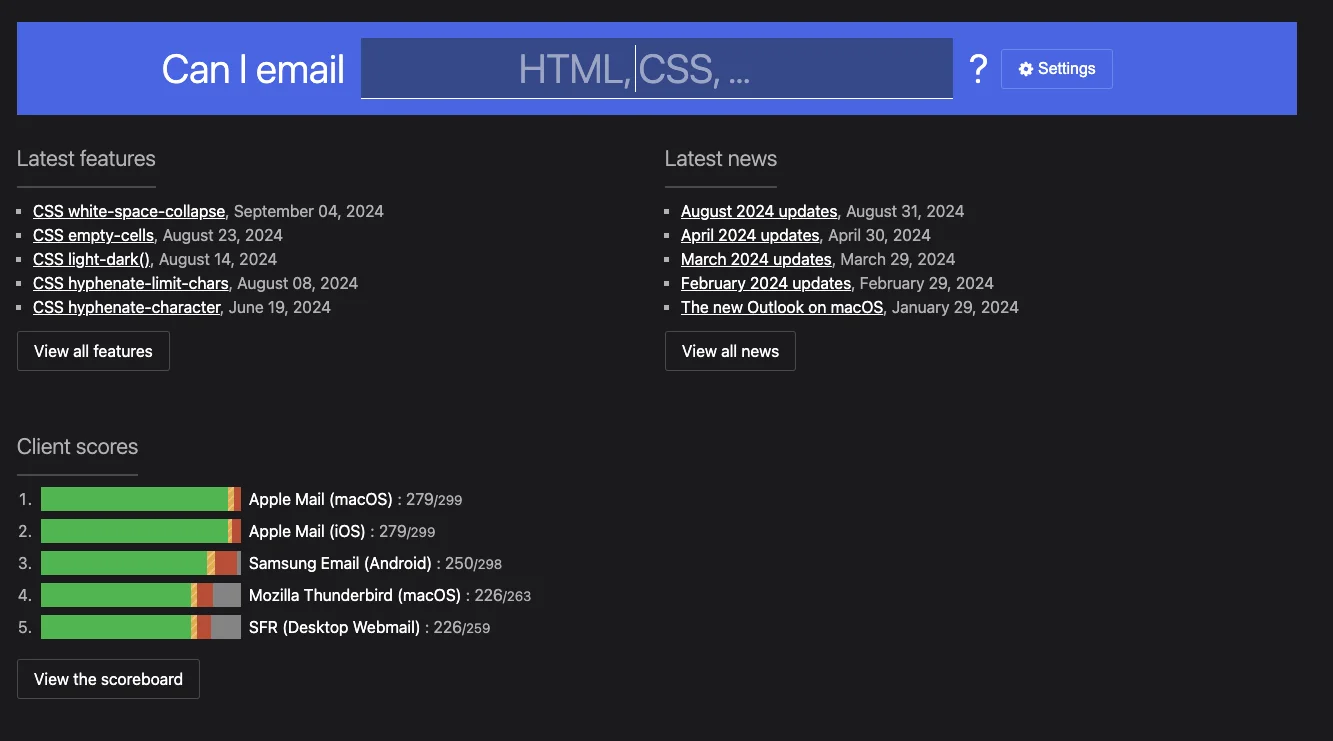
Responsive design
Responsive design is a design technique that automatically adjusts how an email is displayed in any email client. Designing an email using responsive design is essential, given that most users nowadays read their emails on mobile phones. In fact, 80% of email recipients suggested they would delete an email that didn’t display correctly on a mobile.
Therefore, when designing your emails, make sure you use an email editor that uses responsive design by default, such as Email Editor from Sinch Mailjet. To take it one step further, Email Editor even offers a preview feature to help you check how your email is shown in different inboxes, for multiple device makers, versions, devices and countries. No more guessing….

An example of a responsive email design that scales and adapts to a reader’s mobile screen
Templates and components
Templates and libraries see heavy use in web page design. However, it’s also very useful to create a library of components for your email campaigns. Once you have created your library, you can create all your emails with it to ensure that they respect your design guidelines.
This will also allow you to test your entire library to guarantee that any email created from it is displayed correctly. Another benefit of a library is helping you to test different layouts more quickly, either when creating new emails or performing A/B tests on existing emails.
If you need ideas, Really Good Emails and Email Love are two very well-designed email sites. They provide an endless source of inspiration to help you design beautiful emails.
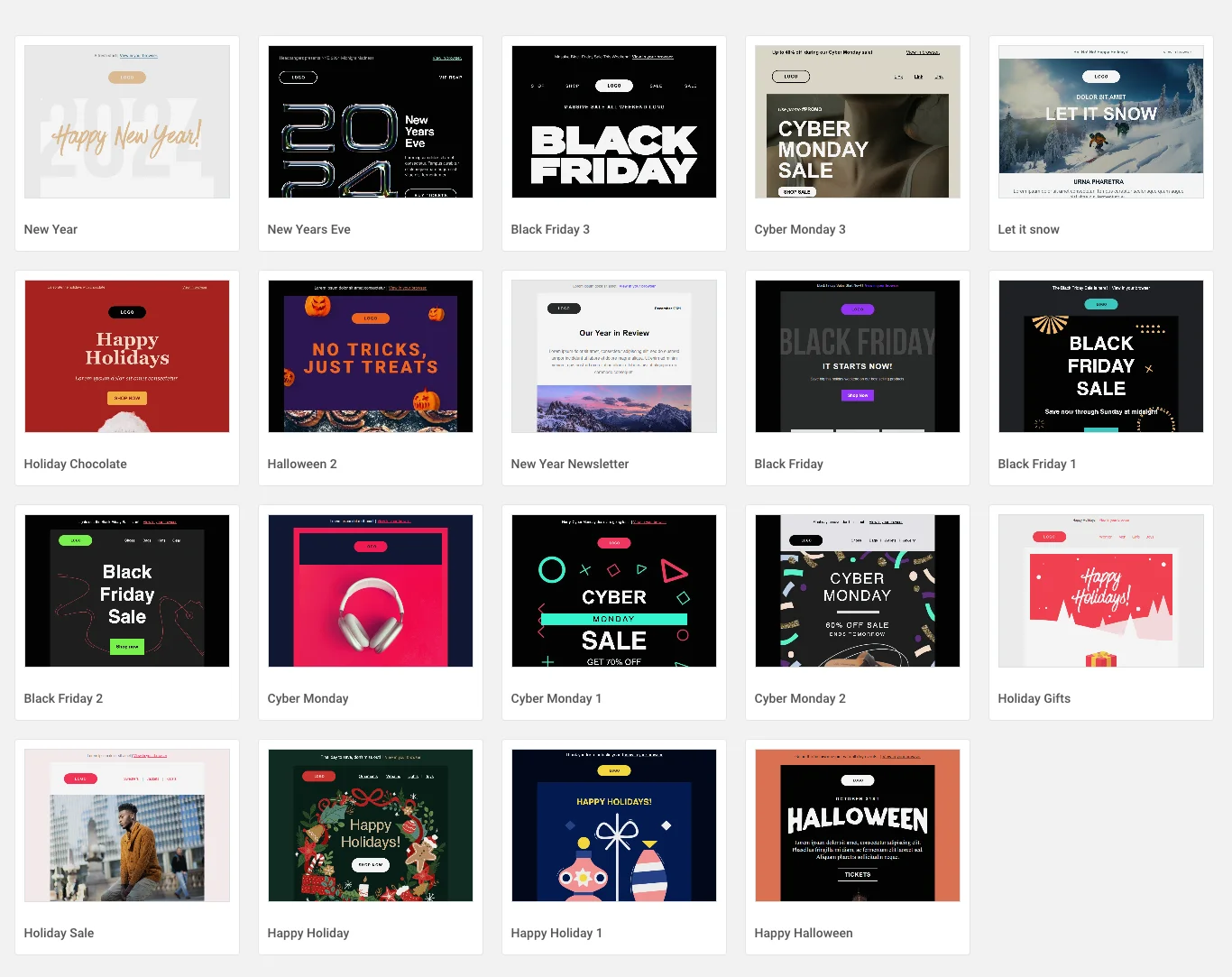
Sinch Mailjet has many pre-designed and stored newsletter templates for you to try out, such as these holiday email templates.
Email design trends
Now that you know the basic email design best practices, it’s time to switch over to trends, and see what’ hot (and what’s not) rolling into 2026. Here are a few that Mike covered in his Email Camp session, Cutting-edge email designs.
Go big, or go home
A new trend that Mike and the team at Really Good Emails is that brands are really pushing hard to stand out from the crowd. And one tactic they’re using is to focus the email around the brand. Not the product, not necessarily the message, but the brand.
Interestingly, many companies are deciding against using their logo, icon, or event trademark to stand out, but rather big bold texts, headlines, and images. Here are a couple of examples:
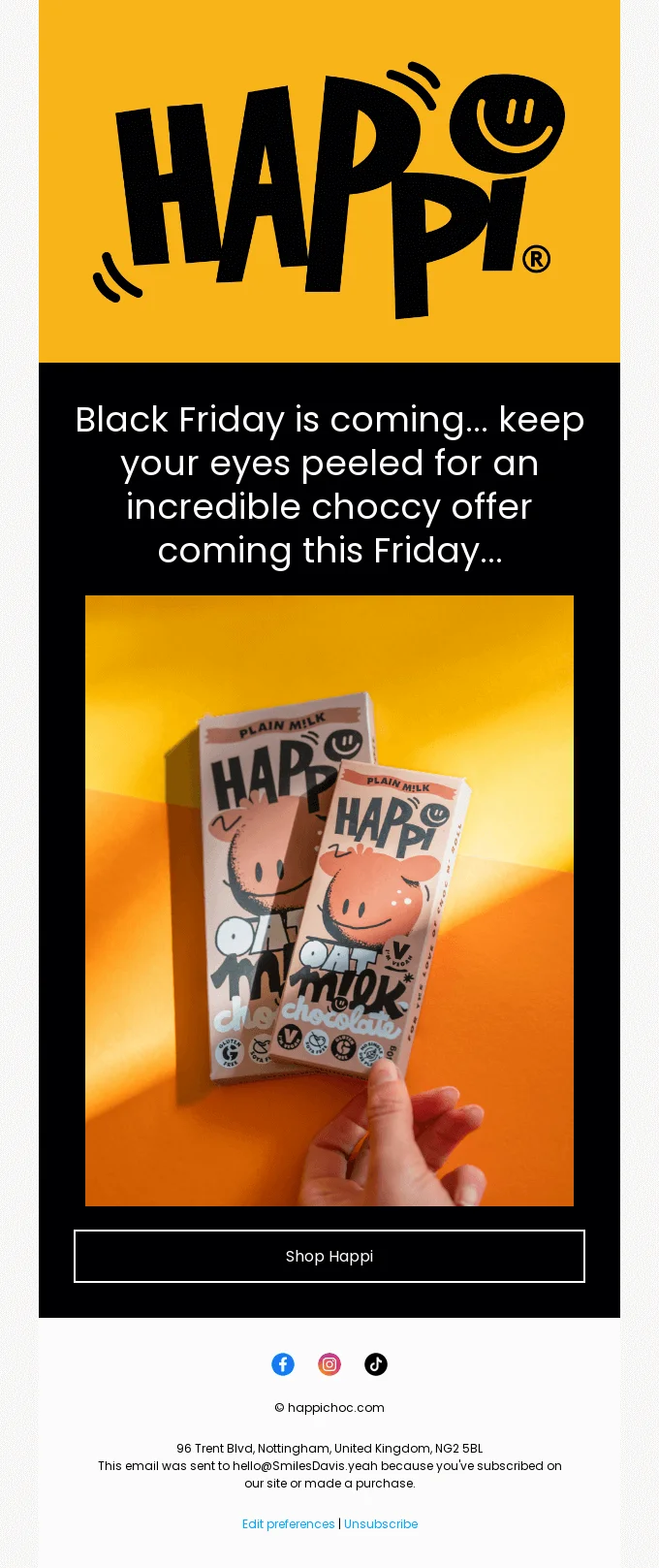
Notice how the team at Happi use the header image to really draw attention to their brand

The same with The Label Edition, as their title draws recipients into the email
Why is it catching on?
It’s become increasingly difficult for brands to stand out as more and more competitors enter the marketplace. So, they’re deciding to be a bit different, a bit quirky. By deviating a little from the typical email design structure, brands are hedging their bets that people will be drawn in and engage with the content.
Hard tables
No, we’re not talking about difficult mental arithmetic. Hard tables in this case refers to brands outlining their content blocks with marked, black lines. The outlines don’t have to be black of course, if you’re sending emails in dark mode then a white hard table can be used:

This example from Arkk shows the same concept being used on a dark background

Whereas this example from XXXI is an example of a hard table on a standard white background
Why is this catching on?
Applying a hard table email designed provides structured clarity to a newsletter. By enclosing content within these tables, readers can visually identify related content blocks making the newsletter appear more organized and easier to go through. This is particularly helpful for newsletters with multiple sections or a large amount of content.
Celeb cameos
This one doesn’t need too much of an explanation – celebrities have been used to market products for over a century now. In fact, since West End actress Lily Langtree appeared on posters for Pears Soap way back in 1882. Seems like this email design trend is having somewhat of a resurgence.

As you can see, Drift employed the services of Andre Drummond to be the face of their email campaign
Why is this catching on?
Having a celebrity be the face of your newsletter campaign adds immediate street credibilityand can enhance a brand’s reputation. If the celebrity is popular with your audience and shares your email on social media, it can go viral, reaching a much wider audience than your typical subscriber base.
Picture wall
So, imagine you’ve just finished a product shoot. The photographer has absolutely nailed it and you’re now the proud owner of 100+ high-quality product images. The only downside is…you now must pick between them. Which ones will make the cut? Which ones will star in your upcoming newsletter? So many tough choices to make, right? Well, maybe not…

Or you could just remove the guesswork and use a bunch of images in a picture wall

Sometimes the images are just too good to be sat in the cloud, right?
Why is this catching on?
Apart from the fact email marketers can’t decide which images to use in their campaigns? No, jokes aside, using a variety of images can help show products from different angles. For example, if it’s an item of clothing, what it looks like worn by people of different people with body types, height, gender, etc. This will better help potential customers picture themselves using the product.
Raw and unfiltered
For those of you reading this from the UK, you might remember the famous John Smith’s No nonsense advertising campaign by English copywriter and Creative Director John Webster. It appears this trend has found its way into email design, as more brands include unedited images and video footage in their newsletter campaigns.

Patagonia open their newsletter campaign with an unedited photo of a dog in the back of a camper van

GiftShop’s collaboration with Parisian restaurant dumbo uses a slide of raw, unedited images from the kitchen to market their new t-shirt line.
Why is this catching on?
With AI dominating almost every industry conversation (especially AI email marketing) people are becoming a little weary. Everything seems to be artificially created or adapted these days, leading to a sort of counter-culture movement within email design. A lot of brands are reverting back to authentic, original designs and photos within their campaigns.
Remember the environment and accessibility
Email ecology and accessibility are becoming increasingly important in the lives of brands and users and will be at the heart of future email design strategies. Design will have to take into account more ethical and environmentally-friendly criteria.
When we talk about email and environment, there are really two points where we can have a positive influence: data storage and display.
There are several simple ways to reduce your email carbon footprint:
- Reduce image sizes
- Reduce the complexity of the email to reduce the size of the HTML code
- Think about how “dark mode” can impact your email design
- Think about the brightness of your designs
- Include a message asking the user to delete the email after reading it
In terms of accessibility, more than 1.3 billion people live with some degree of visual impairment. Your goal is to help these people read emails as easily as possible. This joins another current trend, which is voice assistants that are progressively beginning to read messages. To allow these tools to work, you have to take into account certain practices:
- Structure the message
- Prioritize content
- Use contrasting colors
- Optimize HTML code
How Sinch Mailjet can help you
Mailjet’s email marketing solution allows you to easily create beautiful designs for your emails. Thanks to an intuitive drag-and-drop email builder, you can design 100% responsive email campaigns that show perfectly on any screen in just a few clicks. Try it for yourself.
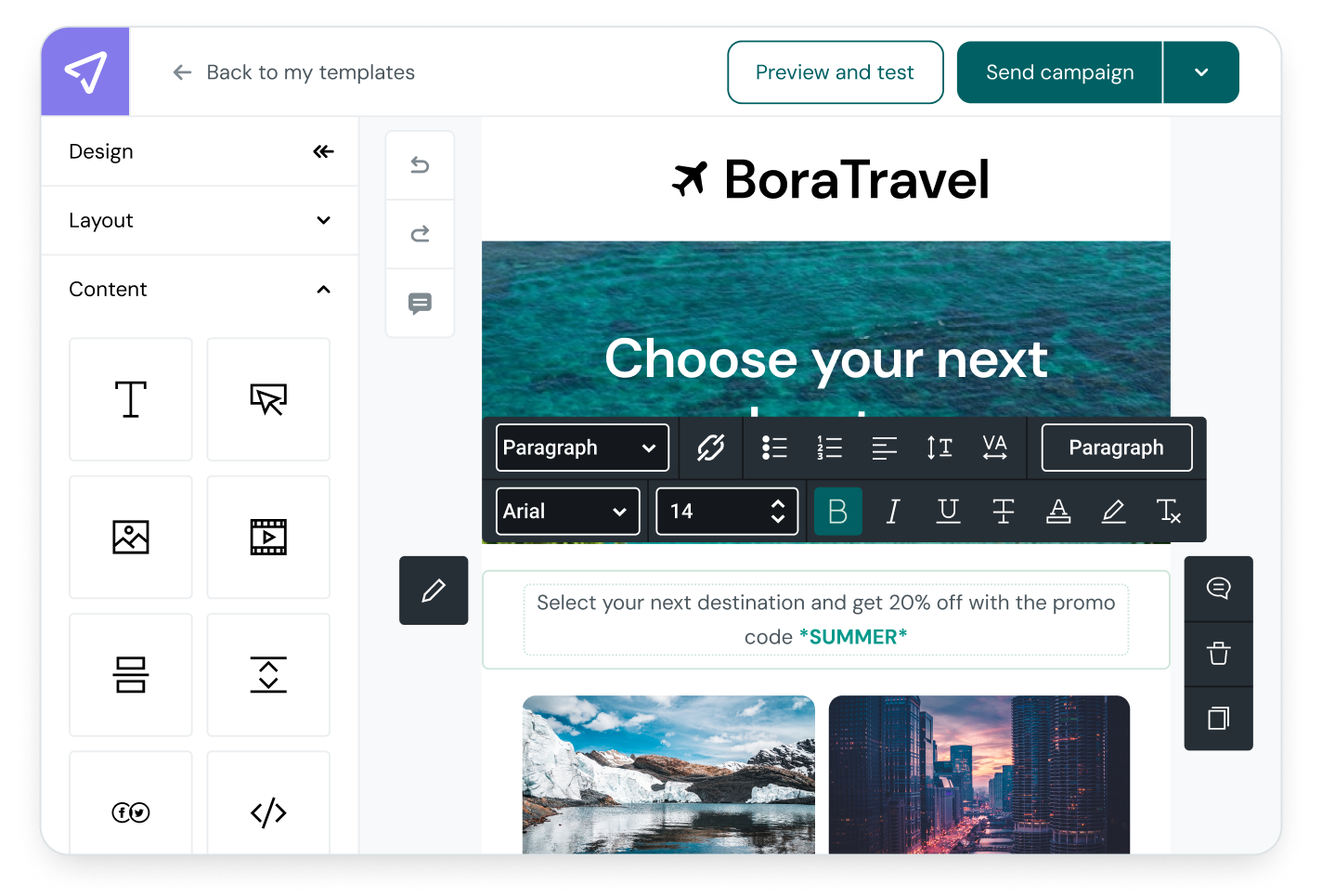
Mailjet’s email template gallery will save you time when creating your campaigns, so you can focus on optimizing your emails’ performance. Mailjet also offers many advanced features such as email segmentation, personalization and A/B testing.
The post Email design trends and best practices (2026) appeared first on Mailjet: Email Delivery Service for Marketing & Developer Teams.
]]>The post Email marketing trends to watch for in 2026 appeared first on Mailjet: Email Delivery Service for Marketing & Developer Teams.
]]>At Mailjet, we’re constantly analyzing the landscape across email senders, industry data, and broader communication trends. Below, we break down 7 data-backed predictions email marketers and senders should watch for in 2026, and what you can do today to stay ahead.
Table of contents
The state of email heading into 2026
Despite louder competitors – yes, chat apps and AI assistants, we’re looking at you – email remains one of the most powerful and popular communication channels on the planet. In fact, Statista projects global email users to reach 4.7–4.8 billion by the end of 2026, with the number of emails sent daily expected to hit around 392 billion.
This sentiment was echoed in Sinch’s The state of customer communications report – published earlier this year – where a global survey of consumers selected up to three channels on which they’d like to receive promotions from brands.

As you can see, the tried-and-tested channel came out on top at nearly 77%.
So, while inboxes may evolve, change, and adapt to consumer needs – they’re not going away anytime soon. And those marketers and senders who evolve with them will win.
7 predictions for email marketing in 2026
#1 “Intelligent inboxes” will reshape how email is delivered and discovered
As email marketers and senders, we’ve moved past the era of one-size-fits-all campaigns. For years, we’ve relied on the standard playbook: using a subscriber’s first name or creating a few broad segments to make our emails feel more personal.
While this was a step in the right direction, today’s crowded inboxes and high customer expectations demand more. Simply put, basic email personalization is no longer enough to cut through the noise.
A major shift is already underway. By 2026, inbox providers like Google and Apple will play an even greater role as intelligent gatekeepers for your audience. Their systems will increasingly decide which messages get priority, which get summarized, and which get relegated to a secondary tab. The battle for the primary inbox is heating up, and the rules are changing.
So, how do you ensure your messages make the cut?
To earn and keep your place in the inbox, you must deliver demonstrable value. This means moving beyond generic promotions and using data to create truly relevant experiences that anticipate your customers’ needs.
Sinch research shows that 42% of consumers expect personalized promotions, and nearly 30% expect brands to use their purchase history to send them more relevant messages.
For marketers, this means one thing: relevance becomes the new deliverability. If your message isn’t behaviorally targeted, timely, or genuinely useful, it will increasingly get filtered into secondary tabs – or quietly ignored.
Action for 2026:
Shift your strategy from “send to many” to “send to the right person at the right moment.” Engagement depth (clicks, conversions, replies) will matter more than raw volume.
#2 AI-driven personalization becomes standard, not “innovative”
Mailjet’s 2025 report highlighted the rising dependency on AI to speed up campaign production, improve segmentation, and personalize content. In 2026, expect that to go mainstream.
For example, Mailjet recently rolled out its new open-source MCP Server – a bridge that lets conversational-AI tools connect directly and securely to Mailjet’s API. This means marketers and senders no longer need to manually export dashboards or write SQL/data-analysis scripts to get insights.
Instead, you can literally ask in plain language questions such as: “Show me the open and click-through rates of our last campaign by country,” or “Which segment had the highest unsubscribe rate last month?” for immediate, actionable answers.
Here are just a few ways you can leverage AI in email marketing to deliver the relevant campaigns your audience will come to expect from your brand:
| Use case | Description | Example query |
| Hyper-specific performance analysis | Go beyond simple open and click rates. Ask the AI to pull detailed reports on campaign performance. | “Show me the top 5 countries by open rate for my last campaign. Also, what was the bounce rate for Gmail addresses?” |
| Automated content and template management | Let the AI help plan your content. Ask it which existing template performs best to help inform your next design. | “Pull up all my newsletter templates in the ‘Monthly Digest’ category. I want to reuse the one from last month.” |
| Workflow monitoring and optimization | Keep a close eye on your automated email sequences. Query the performance of a specific workflow to identify drop-off points. | “What’s the open rate for the third email in my ‘New User Onboarding’ workflow? Show me the stats for the last 7 days.” |
This isn’t about more emails – it’s about smarter emails that feel tailor-made for every recipient.
Action for 2026:
Audit your tech stack. If your tools can’t handle behavioral segmentation, dynamic content, or AI optimization, you’ll be at a disadvantage.
#3 Authentication and trust signals become non-negotiable
Stricter inbox rules from Google, Yahoo, and other major providers have pushed email authentication from best practice to bare minimum, especially for bulk email senders in 2025–2026. SPF, DKIM, and DMARC now form the essential identity layer that proves a sender is legitimate and that messages haven’t been altered.
Yet adoption is still uneven. Mailjet’s Road to Inbox 2025 report shows that while 66.2% of senders use both SPF and DKIM, more than 25% aren’t sure whether they’re authenticated at all, and only about 53.8% have a DMARC policy, many of which remain at the non-enforcing “p=none” level. As inbox providers continue tightening requirements, that gap becomes a real risk.
So, for 2026, authentication won’t just determine whether you make it to the inbox – it will increasingly shape how inbox providers rank, filter, or flag your messages. Stronger DMARC enforcement (quarantine/reject), aligned authentication across all sending domains, and consistent domain reputation will be baseline expectations.
It also becomes the gateway to added trust signals like BIMI, which allows brands to display their official logo in inboxes, but only after DMARC is properly enforced. In a world of phishing, spoofing, and rising user skepticism, authenticated identity becomes a core element of brand trust, not just a technical spec.
Authentication also directly supports the other email trends emerging for 2026, especially AI-driven personalization and dynamic content. These advanced, data-informed email experiences only work if the message reliably reaches the inbox – and inbox placement now depends as much on technical trust as on engagement.
With smarter inboxes evaluating sender reputation, identity, domain alignment, and user behavior together, authentication becomes part of a broader deliverability profile. For senders adopting lifecycle automation, predictive content, or micro-segmentation, authentication ensures these efforts aren’t undermined before the email is even seen.
Action for 2026:
Get ahead of evolving requirements now. Review domain authentication, enable alignment, and maintain meticulous email list hygiene.
#4 Email becomes part of a unified omnichannel conversation
In 2026, email will increasingly be just one part of a larger, omnichannel marketing strategy. Not operating in a silo, but as a central node in a web of channels including SMS, chat/messaging, in-app notifications, and more. By treating email as the backbone of this strategy brands can reach customers where they are, and then build additional touchpoints around that core.
The value of an integrated approach gets real when considering engagement and customer experience. When channels are connected and data flows seamlessly between them, for example, when a user clicks a link in an email, browses a website, and later receives a timely SMS or in-app reminder – the company no longer just pushes messages, but orchestrates a connected customer journeys that feels cohesive and responsive.
For marketers, that means 2026 is the time to move from “email-first” thinking to “customer-journey-first” thinking. Build your flows so that email triggers, such as welcome messages, promotional newsletters, transactional information, etc. are just one leg of a broader journey. Layer on SMS or push notifications for time-sensitive alerts; use chat or in-app messaging for support or re-engagement; and ensure that customer data (preferences, behavior, status) is shared across channels so every interaction feels informed and personal.
Action for 2026:
Embrace quality over quantity. Build programs that send fewer but far more impactful messages informed by behavior, lifecycle stage, and customer intent.
Map your lifecycle journeys across all channels, not just email. Ensure consistent messaging and fluid transitions.
#5 Email design becomes lighter, greener, and more interactive
Email design in 2026 is moving decisively toward lighter, faster, and more sustainable experiences. Heavy emails with oversized images or bloated HTML slow load times, hurt deliverability, and create friction for mobile users. The emerging best practice is a minimalist, mobile-first approach: optimized image sizes, streamlined code, balanced text-to-image ratios, and layouts that prioritize clarity over decoration.
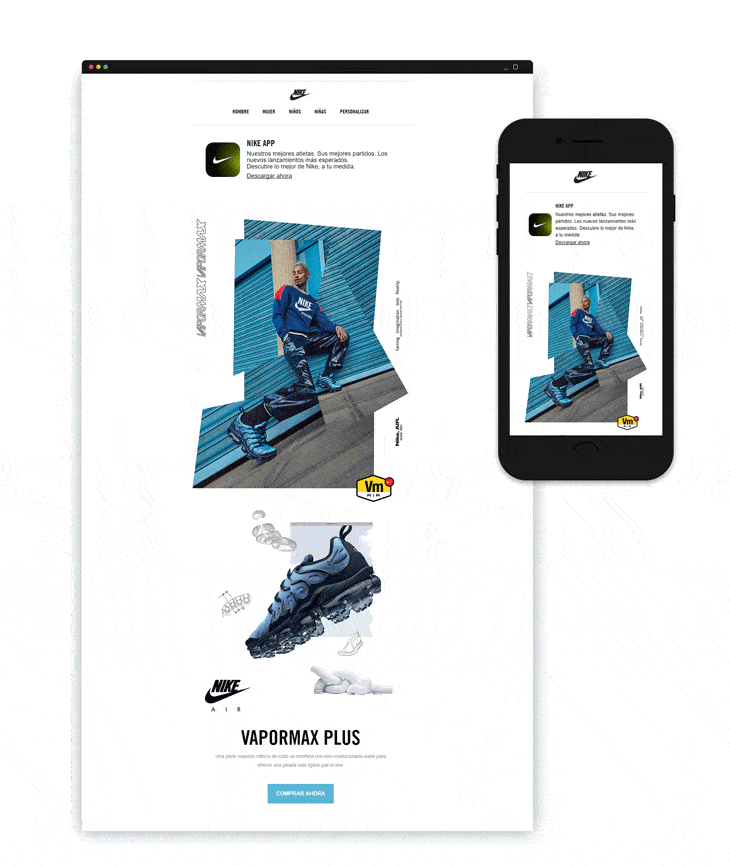
These leaner builds not only improve rendering across inbox providers but also reduce the environmental footprint of each send – a growing priority for brands aiming to operate more consciously.
Sustainability also walks hand-in-hand with accessibility. Lighter emails are inherently more accessible, but 2026 design trends will go further: ensuring strong contrast, meaningful alt-text, clear structure, and reliable dark-mode support. This is in part due to the European Accessibility Act (EAA) – a key regulation aimed at making digital experiences more inclusive by requiring businesses to remove accessibility barriers coming into effect in June 2025. But also just good practice.
This focus makes each message more inclusive for every subscriber, whether they’re using assistive technology, reading on low-bandwidth connections, or opening emails on older devices. Cleaner design and optimized assets reduce cognitive load while ensuring emails load quickly, look good everywhere, and meet the rising expectations of both users and mailbox providers.
Action for 2026:
Adopt modular design systems and ensure every element of your email is optimized for speed, accessibility, and clarity.
#6 The KPIs that matter will shift
Open rates have already become less reliable thanks to privacy changes (like Apple MPP), but intelligent inboxes will accelerate the shift away from opens.
Instead, marketers are focusing on measurable actions such as click-through rate, time spent reading, and downstream conversions, which more accurately reflect whether an email is delivering value. These metrics align with how mailbox providers evaluate sender reputation, making them essential not just for performance reporting but also for ongoing deliverability.
Another major shift we’re likely to see is the growing importance of quality-of-engagement metrics – the behaviors that demonstrate genuine subscriber satisfaction. Positive signals such as regular engagement, safe-listing, and folder movement now carry more weight than ever, while negative signals like rapid deletes, ignore patterns, and spam complaints can quickly degrade reputation.
We must move away from the traditional marketing math of “send a million messages and hope that 10% get opened”. This transactional view must be replaced by relationship building through valuable, prompt-based discussion
Finally, KPIs tied to list health and infrastructure reliability are becoming critical. Bounce rates, spam complaint ratios, email authentication pass rates (SPF/DKIM/DMARC), and domain-level reputation data are no longer considered technical afterthoughts but core business indicators. Advanced senders are layering in new diagnostic KPIs such as inbox placement rates, blocklist monitoring, and segmentation-level engagement performance to gain a fuller picture of how mailbox providers perceive their program.
Action for 2026:
Rebuild your dashboards. Modern email success isn’t about who opens – it’s about who takes action and returns.
#7 Ethical data use and transparent consent will define brand reputation
In today’s crowded inbox, earning your subscribers’ trust is harder than ever. Your audience is on high alert, thanks to a constant barrage of spam and sophisticated phishing attempts. This heightened caution means that even your legitimate marketing emails are often met with suspicion. In fact, our research shows that 53% of consumers have received a legitimate email from a brand that they initially thought was fraudulent.
This creates a huge deliverability and engagement challenge. If your subscribers don’t trust your message, they won’t open it.
By 2026, the most successful email programs will be those that make trust visible. The focus will shift from simply reaching the inbox to proving you belong there. To do this, you’ll need to master two key things: making every email visibly authentic and ensuring the entire customer journey is secure and seamless.
First, brands will need to provide instant, visual proof that their emails are legitimate. For email marketers and senders, this means going beyond the “From” name and embracing sender authentication technologies that have a visible impact.
This is where BIMI, built on the foundation of DMARC enforcement, becomes essential. BIMI allows you to display your official brand logo directly next to your message in the subscriber’s inbox, acting as a verified checkmark that immediately separates your emails from potential fakes. It’s the most powerful way to show, not just tell subscribers that your message is authentic.

Action for 2026:
Make your email program a model of privacy, transparency, and respect. It pays off both in deliverability and customer loyalty.
What’s next in 2026?
The pace of change in email marketing is accelerating, and it’s easy to feel like you’re constantly adapting to new technologies, new rules, and new subscriber expectations. But the truth is, you don’t need to overhaul everything overnight. The most successful email programs in 2026 are built on continuous testing, thoughtful experimentation, and a willingness to innovate.
With the right tools and trusted expertise, staying ahead of these trends becomes far more manageable. Sinch Mailjet’s collaborative, creator-friendly platform is designed to help marketers move faster and smarter. From building accessible, high-impact templates to managing audience data responsibly and optimizing performance with clarity. Whether you’re enhancing deliverability, adopting AI-powered workflows, or scaling omnichannel journeys, our tools make it easier to build campaigns that truly resonate – and reliably reach the inbox.
And we’re here to guide you every step of the way. The Sinch Mailjet team is deeply committed to helping senders navigate the evolving email landscape. Explore our blog, dive into our resources, and subscribe to our newsletter to stay ahead of the insights shaping the future of email.
Send me the Sinch Mailjet newsletter.
The post Email marketing trends to watch for in 2026 appeared first on Mailjet: Email Delivery Service for Marketing & Developer Teams.
]]>The post Email marketing with Model Context Protocol (MCP): What it is and why it matters appeared first on Mailjet: Email Delivery Service for Marketing & Developer Teams.
]]>At the Guru Conference 2025, Mailjet’s Principal Product Manger, Natalie Lynch, presented a forward‑looking session titled Smarter than the Inbox: AI for Real Email Results, exploring how Model Context Protocol (MCP) is reshaping the way email marketers and senders work. Rather than simply automating email sends or personalization, MCP enables marketers to shift from static dashboards toward conversational, question‑driven access to data and campaign performance.
The result: faster insights, more agility, and campaigns that feel personalized – not just “bespoke for segments” but “written for me”. The session focused on what MCP connectors are, how they work in practice for email marketing, what pitfalls to watch, and how to begin without over‑engineering.
Below you’ll find the key learnings from the session, followed by the full recording and a FAQ to help you and your team explore MCP in your email‑marketing stack.
Table of contents
Smarter than the Inbox: full session recording
Catch the full recording of Natalie’s session below:
Key takeaways from the session
Want the TL;DR?
What is an MCP connector?
Natalie described an MCP connector as AI that speaks your language – built for marketers, not machines. It bridges your email system, analytics, and AI assistant so you can ask plain‑language questions (e.g., “Which reactivation email performed best this quarter?”) and get answers immediately, instead of digging through dashboards.
From dashboards to dialogue
Traditional email marketing workflows rely on charts, CSV exports and manual analysis of opens/clicks/unsubscribes. But with MCP, you begin by asking a question and the connector fetches relevant data, highlights performance, and surfaces the why behind what happened. The analogy she used was “Instead of flipping a Rolodex you just say “Call Mom”.
MCP on one real workflow
Rather than overhaul everything, Natalie recommends starting with one workflow (e.g., your monthly report deck) where you replace manual steps with “ask the AI assistant via MCP” and let data lead. That becomes your proof‑of‑concept.
Data quality matters
If your CRM/ESP data is messy, the MCP will shine a light on inconsistencies (and make them obvious). Entities like segments, tags, send-times must be aligned and clean – otherwise the answers will be noisier.
Pitfalls and where AI needs human oversight
MCP is a tool, not a silver bullet. AI can confidently give wrong answers; marketers must interrogate the results and ensure good questioning. Also, over‑personalization can backfire. Remember the difference between “We thought you’d like this because you bought sneakers” (good) and “We saw you walk past our store at 3:12 yesterday” (a tad creepy).
Speed‑to‑insight becomes competitive advantage
The value of MCP connectors isn’t in radically new metrics, but in making insight generation much faster – so you can iterate, experiment and optimize at the pace of curiosity rather than the pace of reporting cycles.
You can see how it works in Mailjet below:

FAQ: What email marketers ask about MCP
1. What’s a simple way to get started with MCP?
The easiest way to start is to connect a conversational AI tool (like Claude or ChatGPT) to an MCP-compatible server – such as the open-source one Mailjet now provides. From there, you can ask plain-language questions and retrieve live data from your Mailjet account. You can find more info on our recently published article “MCP: A new era for email marketing data” where you get a deeper insight into difference use cases and how to set it up. If you are even more curious then check out our Mailjet documentation on implementing MCP.
A good first step? Replace a single reporting task – like building your monthly performance deck – with a simple prompt:
“Compare the open and click rates of our March and April campaigns. What drove the difference?”
That’s your proof of concept.
2. Is there a cost associated with using an MCP Connector?
Mailjet’s MCP Server is open source and free to use. The cost comes down to your AI assistant of choice and how you deploy it. If you’re already using tools like Claude or OpenAI’s ChatGPT Pro, integration may be simple and low-cost – especially for read-only use cases. For teams scaling across departments or use cases, you may want to invest in custom hosting, API rate-limit adjustments, or premium AI tools for broader access and stability.
3. How is proprietary data kept safe when using MCP?
Security is a top priority. Mailjet’s MCP Server offers read-only access by default, meaning your AI assistant can retrieve data but not modify it. That’s intentional so marketers can explore insights freely without risking changes to production data.
For developers, the server is fully extendable. You can define exactly which Mailjet API endpoints are exposed and implement strict access controls, monitoring, and encryption. It’s a controlled, transparent setup designed with safety and compliance in mind.
Unlock your campaign insights with AI now
The Mailjet MCP Server redefines email analytics by connecting your Mailjet platform to the power of conversational AI. It’s designed for both marketing and development teams who want to unlock deep, actionable insights from their email data simply by asking questions.
Ready to start the conversation with your data?
Send me the Sinch newsletter.
The post Email marketing with Model Context Protocol (MCP): What it is and why it matters appeared first on Mailjet: Email Delivery Service for Marketing & Developer Teams.
]]>The post Meet the Mailjet MCP Server: A new era for email data appeared first on Mailjet: Email Delivery Service for Marketing & Developer Teams.
]]>That’s no longer a hypothetical. Welcome to the world of conversational AI-powered analytics. Mailjet is thrilled to add its open-source MCP (Model Context Protocol) Server to its suite of AI-powered tools, a new way for email marketers, senders, and developers to redefine their relationship with data.
Table of contents
What is an MCP?
Think of an MCP as a universal translator that allows a conversational AI, like Claude, to talk directly and securely to another application’s API, in this case, Mailjet’s. It acts as a bridge, enabling you to use plain, natural language to ask complex questions about your email performance and get immediate answers. Instead of navigating through dashboards and manually filtering data, you can now have a direct conversation with your analytics.
Why this is game-changing for email marketers
The Mailjet MCP Server marks a fundamental shift from rigid dashboards to a fluid, natural language interface. This isn’t just about convenience; it’s about transforming how you work and strategize.
| Benefit | How it helps you |
| Save time | Stop spending hours building reports. Get the metrics you need, instantly. Ask a question, get an answer. It’s that simple. |
| Enhance flexibility | Go beyond the limitations of pre-built dashboards. Ask follow-up questions, dig deeper into specific segments, and let your curiosity guide your analysis. |
| Improve strategic insights | With faster, easier access to data, you can spend less time on manual analysis and more time on strategy, A/B testing, and campaign optimization. |
You can see how it works in Mailjet below:

Some practical use cases for marketers and senders
So, what does this look like in practice? Here are just a few ways you can leverage the Mailjet MCP Server to elevate your email marketing:
| Use case | Description | Example query |
| Hyper-specific performance analysis | Go beyond simple open and click rates. Ask the AI to pull detailed reports on campaign performance. | “Show me the top 5 countries by open rate for my last campaign. Also, what was the bounce rate for Gmail addresses?” |
| Automated content and template management | Let the AI help plan your content. Ask it which existing template performs best to help inform your next design. | “Pull up all my newsletter templates in the ‘Monthly Digest’ category. I want to reuse the one from last month.” |
| Workflow monitoring and optimization | Keep a close eye on your automated email sequences. Query the performance of a specific workflow to identify drop-off points. | “What’s the open rate for the third email in my ‘New User Onboarding’ workflow? Show me the stats for the last 7 days.” |
For the developers: A look under the hood
For our technical audience, the real magic of the Mailjet MCP Server lies in its architecture. This isn’t just a new feature; it’s a commitment to open standards and developer efficiency.
At its core, MCP is a standardized API framework built on JSON-RPC, a lightweight remote procedure call protocol. It was open-sourced by Anthropic to create a common language between AI models and real-world APIs, using a familiar request/response pattern that’s a natural fit for the web.
The architecture consists of three key components:
- The AI Assistant (Claude): The conversational interface where the user makes a request.
- The MCP Server: The open-source middleware you host. It translates the AI’s standardized JSON-RPC call into a specific Mailjet API request.
- The Mailjet API: The final destination for fetching the requested data.
By default, the server provides read-only access to your email data, giving your team the freedom to explore and analyze performance without any risk to your production environment. For advanced use cases, developers can easily extend the implementation to enable write-access endpoints if needed.
This approach allows you to interact with the Mailjet API at the speed of thought, turning raw data into actionable business insights in moments.
Unlock your campaign insights
The Mailjet MCP Server redefines email analytics by connecting your Mailjet platform to the power of conversational AI. It’s designed for both marketing and development teams who want to unlock deep, actionable insights from their email data simply by asking questions.
Ready to start the conversation with your data?
Send me the Sinch newsletter.
The post Meet the Mailjet MCP Server: A new era for email data appeared first on Mailjet: Email Delivery Service for Marketing & Developer Teams.
]]>The post 87 email subject line ideas and examples for your Halloween campaigns appeared first on Mailjet: Email Delivery Service for Marketing & Developer Teams.
]]>Fear not – we’ve got you covered.
Here, we’ll show you some shockingly good Halloween email subject lines from your industry and share our recipe for higher open rates. Then, we’ll head to the lab, run through some A/B tests, and discover why data should decide your Halloween-style subject line. You can come out from under the bed now.
Table of contents
37 Halloween email subject line examples for every sector
You have around 40 characters to convince your reader to open an email. No pressure.
Knowing your audience is key. There’s no one-size-fits-all when it comes to email subject lines, but you can definitely draw inspiration from what other brands are doing.
Get your creative juices flowing with these email subject line examples from different industries.
Ecommerce & retail
Everyone loves a “spooktacular deal.” Online shops are in a prime position to offer scary savings and Halloween flash sales. Sometimes, a short mysterious message is enough to pique a reader’s curiosity. Or, you could be cheeky and ask the reader a direct question – come on, what are you scared of?
Check out these creative Halloween subject lines from ecommerce and retail brands:
- Club Kiddo – Boo Ya!
- Paper Source – Get These Spooktacular Best Sellers Before They Ghost!
- Motif – Trick OR Treat? Why not both? 👻
- Crate And Barrel – All treats, no tricks.
- RIFLE PAPER Co – Send Your Boos Some Love?
- Etsy – Practically Magic
- Yellowmoon.org.uk – A frightfully good offer – up to 50% off Halloween costumes
Tech
Larger tech companies generally want to be perceived as thought leaders, but that doesn’t mean they don’t have a geeky side too. They might not take it as far as ecommerce businesses, but tech brands also know how to get into the Halloween spirit.
Here are some Halloween subject lines from the tech industry:
- Pinterest – Your Guide To Carving Pumpkins
- Grammarly – A Happy Halloween Quiz from Grammarly
- Email Monks – Witching You Happy Halloween
- WeTransfer – Pumpkin spice and all things (not) nice
In comparison, startups are trying to be seen as less corporate and will get away with a more “buddy-buddy” vernacular.
Food & spirits
A Halloween party is nothing without Halloween treats. Tempt your customers this season with tantalizing offers or content they can’t refuse. From trick or treating to parties and movie gatherings, make it clear there are savings to be made in your subject line. Recipe guides are another very popular method to attract users into your email.
Get Halloween subject line ideas from these top food and spirits brands:
- FitOn – 👻 3 Scary Good Meals to Die For 💀
- Dunkin Donuts – Click Your Treat and Earn 3X Points
- Cadbury – 15% Off All Ghoulish Goodies
- Betty’s – Double, double toil and trouble
- Land O’Lakes – 👻 Ghoul, treat yourself with these recipes
- Blue Apron – Forget the candy, this deal is the sweetest one yet!
- Archie Rose – BOOOOO: Introducing our Halloween Monster Smash 👻🎃🍸
- Plant People – Happy Halloween 🎃 Ward off monsters with Wonder Mushroom Gummies
Entertainment
The battle for our attention is fierce around Halloween and you only have one seventh of a Tweet to work with. Curiosity is your best weapon, but that doesn’t mean going too vague or your email will just sound generic. The best email subject lines tease out content. Use imperative words like “see”, “fall into”, or “go” to encourage readers to open the email.
Draw inspiration from these Halloween subject lines from some top entertainment brands:
- Disney+ – See what’s screaming — er, streaming!
- Vimeo – Fall into these sweet new features!
- Universal Orlando Resort – Go Behind the Screams
- Riley at Stanza – Only treats this Halloween 👻
- Lego(R) News – Brick or treat! (Toys)
- The Pokemon Company – 🎃 Tricks and Treats! 🍬
Finance
After the last credit card statement, nobody expects another scary email from their bank. As a trusted institution, it’s best to tread carefully with your subject line. You don’t want to be seen as suspicious and marked as spam. Make sure your subject line clearly states the matter at hand – with Barclaycard, it’s fraud.

1. Barclaycard – Freddy, give fraud a fright this Halloween
Finally, adding some personalization to your subject line conveys trust, don’t you think, Mr Krueger?
Now you have the subject lines cracked, it’s time to create a campaign. Find everything you need in our blog post – Tips and tricks to create stunning Halloween emails.
Home décor
While Halloween decor typically transforms homes into haunted abodes, these home décor companies showed how to bring the festivities to your inbox. See if you can’t unearth some ghoulish email subject lines for yourself with the help from these examples:
- Bed Bath and Beyond – Boo-tiful Upgrades 🎃 Up to 40% Off* Halloween Decor 🦇
- Bed bath and Beyond – 15% off for a Fresh + Frightful Halloween 🎃
- Bed bath and Beyond – 17% off for Your Halloween Feast 🎃👻
- World Market – Set out a deadly spread: It’s a Halloween boo-fet!
- World Market – Fresh from the coven: Our spookiest kitchen finds 👻
- Pottery Barn – Our New Halloween Collection, fright this way…
Transportation and travel
We’re not sure about you, but when it comes to transportation and Halloween, the first thing that comes to mind is Scooby-Doo, Shaggy, and the rest of the gang saving us from the supernatural in the Mystery Machine.
It has to be the most iconic Halloween automobile, right?
While we’re not expecting that much every time we jump into a rental, here are a few ideas for subject lines from fellow transportation/travel brands:
- Europcar – 👻 Halloween is coooming… let’s go! 🚗
- Greyhound – Happy Howl at the Moon Day!
- Greyhound – Book a Spooktacular Getaway
- Jenolan Caves – How Can You Measure the Ghosts at Jenolan? With a Spirit Level!
- Data Cars – Halloween – Treat & Treat
How to write a killer Halloween email subject line
Strong Halloween email subject lines are essential for grabbing attention in crowded inboxes and setting the tone for your campaign. As the first point of contact, they drive open rates and complement your broader Halloween email strategy by creating intrigue, urgency, or seasonal relevance – ultimately boosting engagement and conversions during a high-traffic marketing moment.
But what exactly makes these headlines fit for Halloween?
Get creative with your tone of voice
The holidays are a time of fun and joviality, so take this opportunity to get creative. While writing your subject line, keep in mind that people love authenticity and fun, but be mindful not to stray away from the anchor that is your brand voice.
If your brand voice is human and approachable, then avoid overbearing or indecisive wording.
Take advantage of puns (Hallow-queen) and wordplay (All treats, no tricks) to set the stage for your email content and tap into the mystery and intrigue of Halloween by choosing out-the-box vocabulary like “enchanting”, “magical”, and “potion”.

Even mega corporates get in on the fun
If your brand voice allows so, you can also go wild with punctuation, including exclamations for excitement and question marks to challenge your reader. Use emojis to bring color and fun to people’s inboxes and tempt their cursor to take a look. Don’t abuse them, though – keep it to one to two emojis.
Use marketing psychology to increase open rates
Halloween comes but once a year, so advertise your Halloween sale as “last chance”, creating a feeling of scarcity (or FOMO) in the reader. Your Halloween deals can tie in nicely with a countdown to Halloween marketing campaign. For instance, you could send “One week until…” or “3 days until…” emails to remind your subscribers they are running out of time.

Paper Source – Get These Spooky Best Sellers Before They Ghost!
As always, character length is key. Aim for no more than 40 characters to avoid being cut off by Hotmail, Live, and Yahoo Mail clients. There is evidence to suggest that shorter punchier subject lines can improve open rates. However, every audience is different. The only way to truly know your reader’s appetite is to A/B test a variety of subject lines to determine the winner.
Similarly, highlighting the value proposition of an email can improve open rates significantly. Don’t get lost in wishy-washy Halloween lingo – tell the reader why they should open the email. Whether it’s discounts, free gifts, ideas, or advice, make it clear in the subject header.
If you prefer to save the value proposition for your email body, try something short, mysterious, and punchy like this email from Etsy and use the preheader to complement your subject line.
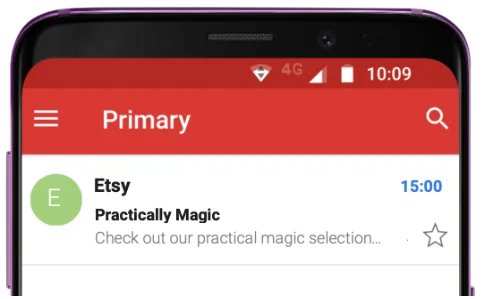
Make it personal with contact properties
Personalize your campaign with contact properties. Nothing grabs your attention more than hearing your own name. Your ears perk up – it’s a reflex response.
Yet, many email marketers still don’t personalize email marketing, giving you the competitive edge if you do. Go further by segmenting your subscriber lists into categories like age and gender. Put yourself in their shoes and adapt your tone of voice for that person.
Avoid the dreaded spam folder
Spam is such a dirty word that we should really call it s***. There are some misconceptions regarding subject line spam words – no, there’s no secret list out there that will take you straight to the spam folder – but certain terms can be deceiving and tend to get lower engagement and higher than normal complaint rates. Just think of all those emails promising a “free” gift. How many of those were actually “free”?
If your sender reputation and email engagement are high, the content of your subject lines probably won’t land your email in spam folders. But if your sender reputation and email engagement are low and you talk like a spammer, chances are you won’t land in the inbox. Spam is a complex and ever-changing subject, so check out our definitive guide on how to avoid spam filters.
Utilize software testing to polish your copy
When you have done everything you can, turn to robots for help. Try running your subject line(s) through an email subject line tester to see how it performs. Once your robot gives you the green light, run the template through an email preview software like Email on Acid to preview emails on all devices and clients.
Lean on AI for a helping hand
While fear is a particularly relevant emotion considering the theme of this blog post, email marketers need to start overcoming it when it comes to AI. In some circles it’s still frowned upon, with traditionalists convinced AI is destroying the craft of copywriting, but that’s simply not true.
Listen, we’re not saying ChatGPT should write all your customer communications. After all, there’s nothing more important than that authentic human touch when it comes to building strong customer relationships.
But AI can help you push through writer’s block within seconds, saving hours in ideation and drafting. Your experience as an email marketing professional is then invaluable in honing that copy – something artificial intelligence cannot replace. But it’s always nice to get a little help to get things started, right?
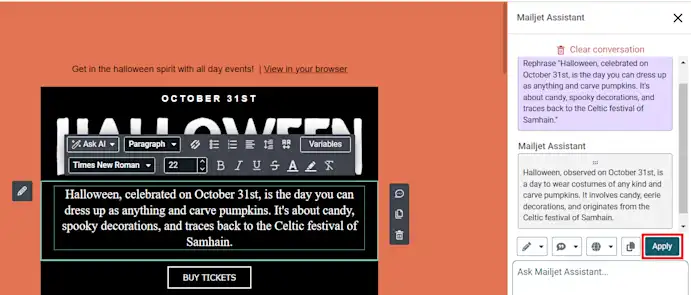
Use Mailjet Assistant – an AI powered tool designed to quickly craft email content in a chat-like experience right within the email builder – to help with your Halloween email subject lines. You can then easily generate, refine, translate, and adjust your text with guided actions and contextual suggestions.
50 Halloween subject line ideas to inspire you
At Sinch Mailjet, we practice what we preach. So, we’ve decided to put ChatGPT to the test and get AI’s helping hand in coming up with 50 ideas you can use to kickstart your Halloween brainstorming sessions.
Below we’ve added 50 Halloween email subject lines coaxed out of Open AI’s generative model. Are they all usable off the bat? No. Are some of them frighteningly awful? Yes. That doesn’t mean they can’t be u to as inspiration for your own creative copy.
ChatGPT’s 50 subject line ideas to promote your sales and drive conversions during the Halloween shopping season:
- “Boo! Get Ready for Spooktacular Savings!”
- “Frighteningly Good Deals Await…”
- “Trick or Treat Yourself to Our Halloween Specials!”
- “🎃 Scare Up Some Savings with Us! 👻”
- “Creep It Real: Our Halloween Sale Starts Now!”
- “Witch Way to Spooky Savings?”
- “No Tricks, Just Treats: Halloween Discounts Inside!”
- “Haunted by High Prices? Not Anymore!”
- “Don’t Be a Scaredy-Cat – Check Out Our Halloween Offers!”
- “Ghosts, Goblins, and Great Deals Await!”
- “Eerie-sistible Halloween Savings Are Here!”
- “UnBOOlievable Savings for Halloween Night!”
- “Halloween Flash Sale: Save Big on Spooky Goodies!”
- “Get Ready to Scream… with Joy! Our Halloween Sale Starts!”
- “Spooktacular Discounts – Shop Now or Never!”
- “Ghoul-tastic Deals Are Lurking…”
- “Hocus Pocus – Savings Focus: Halloween Edition!”
- “Don’t Let These Deals Haunt You Forever!”
- “Pumpkin-Spiced Savings Inside!”
- “Trick or Treat: Pick Your Discount!”
- “Ghostly Greetings and Frighteningly Good Prices!”
- “Boo-kmark Our Halloween Sale Now!”
- “Dare to Click? Exclusive Halloween Discounts Await!”
- “Get Your Boo-ty to Our Halloween Sale!”
- “Don’t Let These Deals Ghost You!”
- “Spooktacular Savings: No Costume Required!”
- “Wickedly Good Deals for Halloween”
- “Unlock the Coffin of Savings: Halloween Edition!”
- “Last-Minute Halloween Savings – Don’t Miss Out!”
- “Halloween Flash Sale: Fang-tastic Offers Await!”
- “Cackle-Worthy Discounts for Halloween!”
- “Goblins Can’t Stop These Savings!”
- “Witches Brew Up Discounts – Grab Yours Today!”
- “Bats, Cats, and Big Discounts – It Must Be Halloween!”
- “Haunted House of Savings – Enter If You Dare!”
- “Spooky Savings for a Fang-tastic Halloween!”
- “Get Your Ghoul On: Halloween Discounts Inside!”
- “Don’t Be a Zombie Shopper – Get Our Halloween Deals!”
- “Ghostly Greetings: Halloween Discounts Have Arrived!”
- “Save Your Soul (and Wallet) with Our Halloween Deals!”
- “No Costume Required for These Spooky Savings!”
- “Boo-tiful Discounts Await: Shop Halloween Now!”
- “Wickedly Good Deals: Halloween Edition!”
- “Cursed with High Prices? Our Halloween Sale Has the Cure!”
- “Pumpkin-Spiced Savings Just for You!”
- “Trick or Treat Yourself to Discounts Galore!”
- “Goblins Beware: Halloween Savings Are Here!”
- “Ghosts Can’t Stop Our Spooktacular Offers!”
- “Sink Your Teeth into Halloween Savings!”
- “Witches and Wizards Shop Here: Halloween Discounts Inside!”
A/B test your Halloween subject line to success
At this point, you may have the most original and engaging subject line to grace the email space. But without A/B testing, you won’t know for sure. Let the audience decide what they like and dislike.
A/B testing is the practice of sending a variety of different subject lines to 20-35% of your audience. The winning subject line is decided by the highest open rate and will be sent to the remainder of your email list.
Here are some A/B test ideas for your Halloween email subject lines:
- Long vs. short subject lines
- Subject lines with and without personalization
- Subject lines with and without emojis
- Negative Statements, questions, and exclamations
- FOMO vs. clickbaity subject lines
- Vague vs. straightforward subject lines
- Subject lines promising discounts or generating a sense of urgency
A/B testing is OK. But A/B/C/D/E/F/G testing is better. That’s why Mailjet’s A/B Testing feature allows you to test up to 10 versions of an email subject line simultaneously. Try a combination of the techniques mentioned above to create subject line variations for testing.
You could try 10 small variations of the same subject line. Or you could go with 10 totally different ideas altogether.
Create Halloween email marketing campaigns with Mailjet
It’s that time of year to celebrate Halloween, go trick or treating, and get creative. However, between email design, AB testing, and subscriber list segmentation – there’s not enough time in the year to work on your marketing strategy.
Mailjet’s intuitive and collaborative email platform comes packed with tons of treats to help with those troublesome details, including two boo-tiful Halloween email templates for your campaigns.
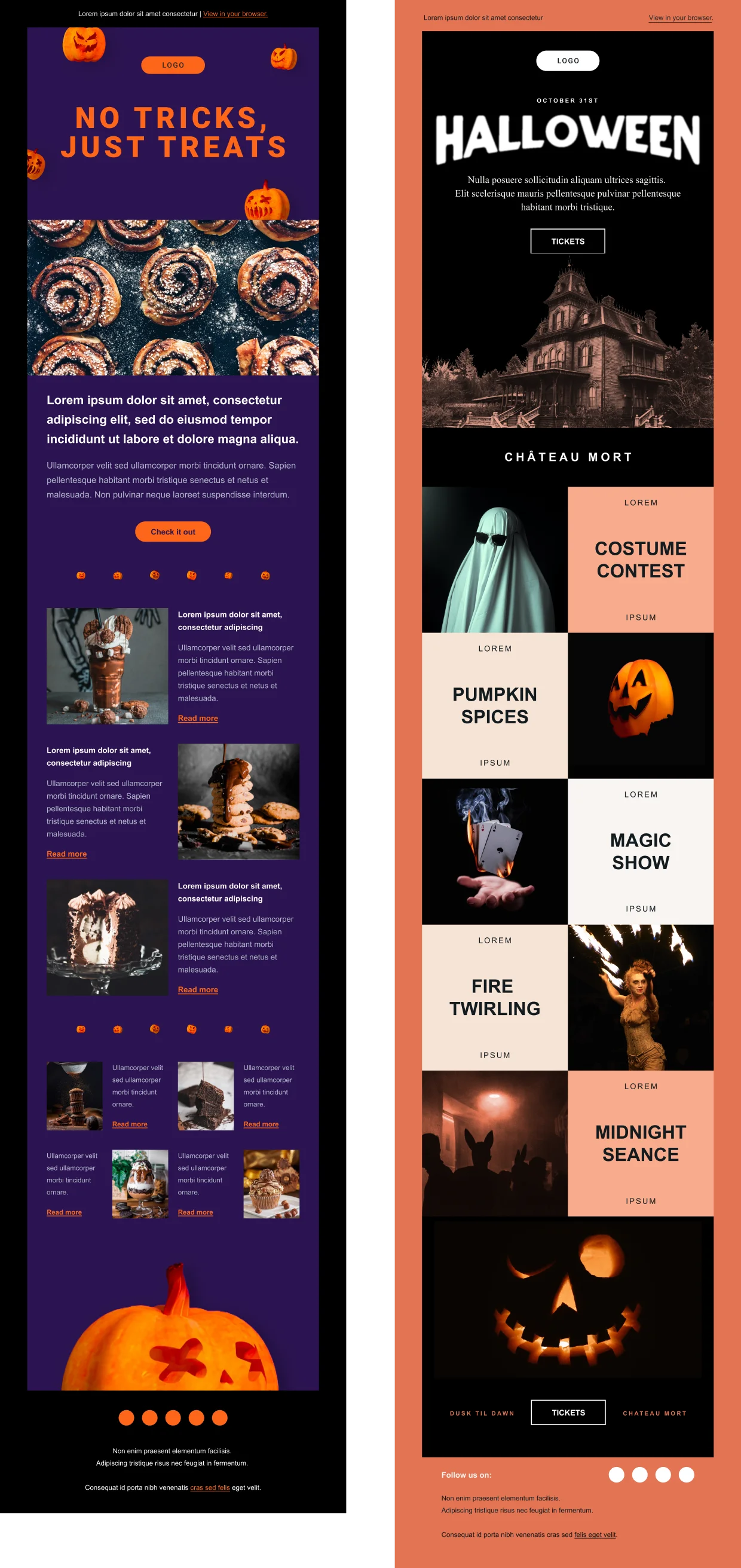
Template examples from Mailjet’s Email Editor
Still looking for help with those Halloween subject lines? Check out Sinch Mailjet’s A/B Testing feature to automatically discover the best-performing headline. You can spend less time with the troublesome details and more time writing that killer subject line. We’ll look out for your Halloween email in our inbox soon!
This is an updated version of the post “21 Eye-Catching Halloween Email Subject Line Examples & Tips” written by Phil Adams and posted on the Sinch Mailjet blog in September 2022.
FAQ
1. What makes a Halloween email subject line effective?
Effective Halloween email subject lines are attention-grabbing, seasonally relevant, and create a sense of curiosity, urgency, or excitement. It should align with your brand voice while tapping into Halloween themes like spookiness, treats, or limited-time offers to encourage opens.
2. How long should a Halloween email subject line be for best results?
The ideal length for a Halloween email subject line is between 30–50 characters. This ensures your message is fully visible on most devices, especially mobile, while leaving enough space to spark interest and include relevant seasonal keywords or emojis.
3. Should I use emojis or symbols in Halloween subject lines?
Yes, when used strategically, emojis and symbols can enhance Halloween subject lines by adding visual interest and reinforcing spooky or festive themes. Just be sure they align with your brand and don’t overpower the message –🕷️, 🎃, or 👻 are popular seasonal choices.
4. What are some examples of high-performing Halloween subject lines for e-commerce?
High-performing Halloween subject lines often include urgency, wordplay, or themed language. Examples include:
- “👻 Scary Good Deals Inside!”
- “Trick or Treat Yourself – 24 Hours Only!”
- “You’ve Been Boo’d – open for a surprise…”
Testing variations can help identify what resonates best with your audience.
5. How early should I start sending Halloween-themed emails?
It’s best to begin sending Halloween-themed emails 2–3 weeks before October 31st, with teaser campaigns or product previews. This gives your audience time to plan purchases or events, while allowing you to build momentum through follow-up reminders or last-minute offers.
The post 87 email subject line ideas and examples for your Halloween campaigns appeared first on Mailjet: Email Delivery Service for Marketing & Developer Teams.
]]>The post Tips and tricks to create stunning Halloween emails appeared first on Mailjet: Email Delivery Service for Marketing & Developer Teams.
]]>To help you out, we’ve handpicked some scarily good ideas to help you spice up your Halloween emails. Check out these tips and start brainstorming how to turn your campaigns from good to…devilishly good.
Table of contents
Ideas and examples for your Halloween email marketing campaigns
Email marketing is an incredibly important communication tool, especially in our current climate. But despite all the doom and gloom, US consumer spending around Halloween is expected to hit $13.1 billion 2025, according to the National Retail Federation’s annual consumer survey. And for those with a sweet tooth, candy and food shoppers are expected to spend around $3.9 billion (up 11% from 2024).
And no matter how things change, email still remains the best digital marketing tool for ROI.

NRF: Planned annual Halloween expenditure in the US from 2015 to 2025.
Wondering how to make the most of this spooky time of the year? Check out these timeless Halloween email tips to help you create a thrilling Halloween-themed campaign.
Include a trick and a treat in your Halloween emails
Take a look at how Postable incorporates a fun GIF into their email to catch your attention and add a good offer of 15% off with a themed code. Not only is this Halloween email example a good way to give the customer a good laugh, but it also cleverly encourages free brand marketing. Take this as an example and start thinking about how you can leverage the power of word-of-mouth marketing (WOM).
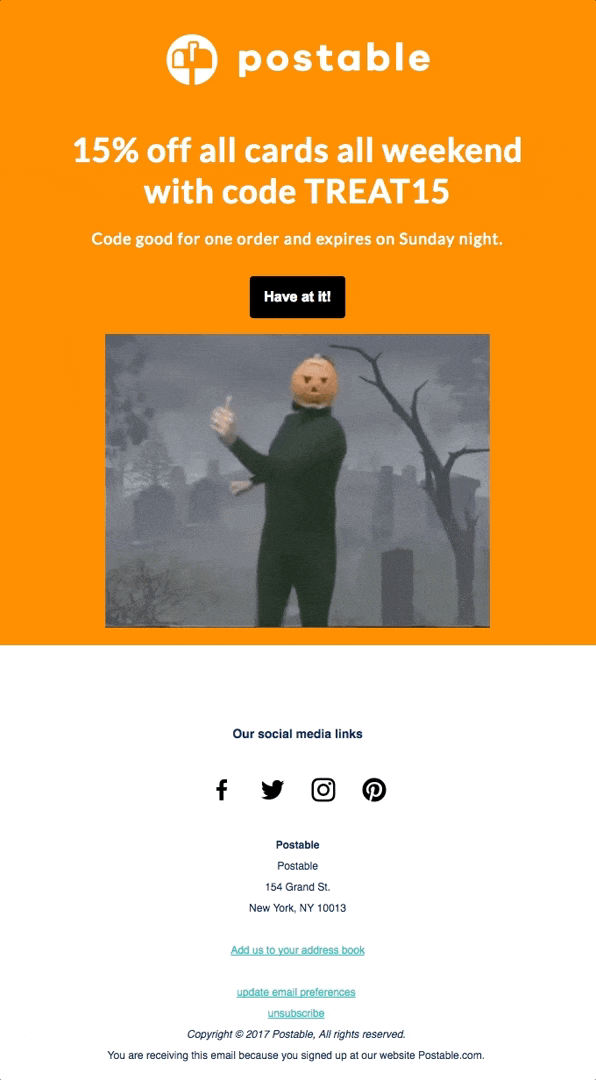
A real treat for those who know Pumpkin Man.
Ensure your Halloween email marketing looks devilishly good
Halloween is the perfect time of year to dress up your emails to give them an edge. LendingTree combines its tried-and-true informative, helpful tone with fun graphics and memorable copy. The subject line is eye-catching, and the email expands on the reader’s curiosity while keeping the tone light. As a bonus, LendingTree cleverly describes the idea of becoming debt-free as being “easy like magic” – thus sticking to the Halloween theme while giving their services a positive connotation.

LendingTree’s Halloween email design is eye-catching and tidy.
Create Halloween emails that build up the suspense
A mystery Halloween sale can be a great way to keep your subscribers hooked and get them to visit your website. EmailMonks’ (now Uplers) “Face Your Fears” Halloween-themed email campaign invites customers to face their fears and step into a haunted house.
Spicing up your emails with a sense of mystery will help your click-through rate, as your contacts are likely to be tempted to try their luck, which translates into visits to your website.
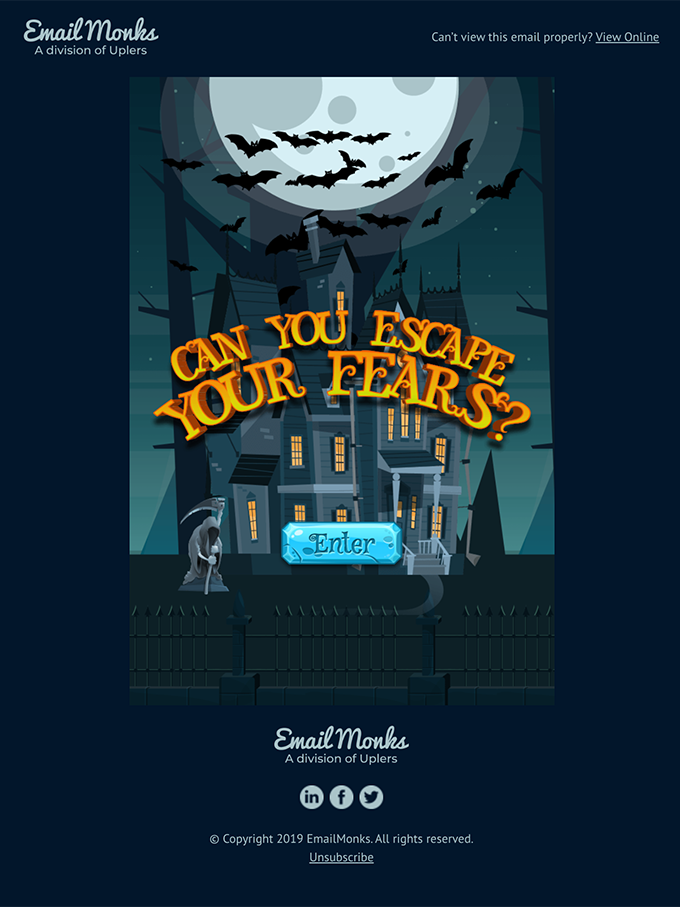
Try including a game in your Halloween email campaign.
Customize your Halloween email marketing campaigns
Engage subscribers with helpful, relevant email. This includes anything from on-trend topics, customizing email to their preferences, or catering to their Halloween needs.
This Crate & Barrel campaign includes useful content for the time-strapped shopper, with links to everything one might need to transform their home into a haunted house radiating that Halloween spirit.
Let the reader know that you have a cure for all their pain points, that you have what they are looking for, and that they won’t need to look anywhere else. They won’t need to do any tiring Halloween decoration shopping after work or trying to craft their own. No more hollowing out pumpkins or applying fake blood…sort their Halloween party in just a few spooktacular clicks!
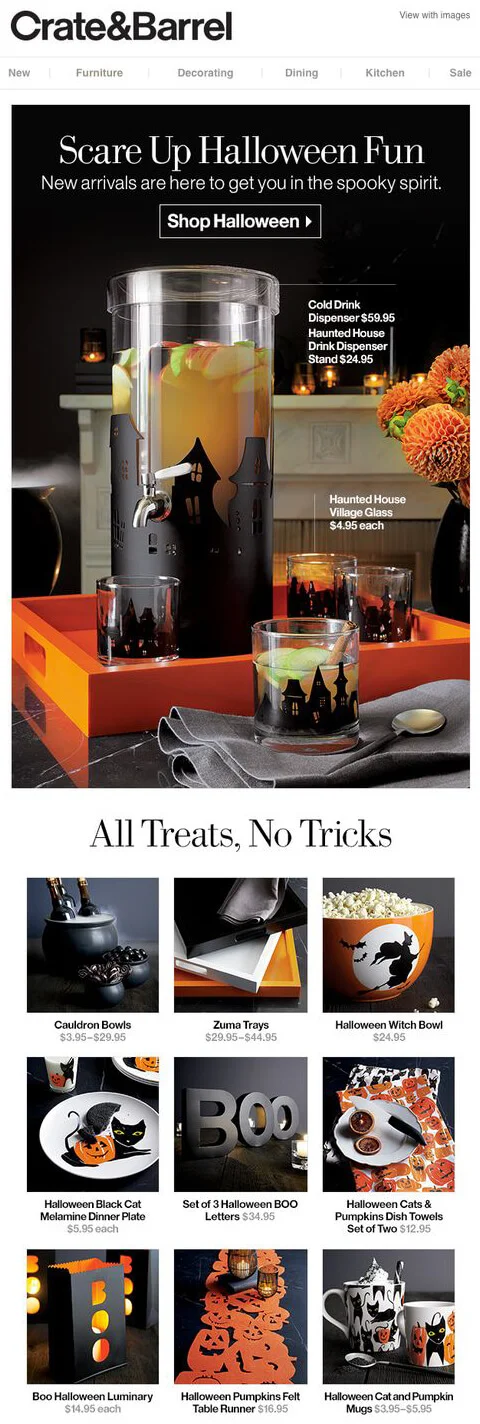
Crate & Barrel’s email includes everything you need to throw the perfect Halloween party.
Free all kinds of creative monsters in your Halloween emails
Make your Halloween email stand out by being bold and using fresh, innovative content. Lands’ End does this cleverly – by bringing its products to life with animation, an element that will most definitely attract the reader’s attention. They also give their email a different twist, opting for “Black Magic” as their title, rather than the usual “Trick or Treat.” They even top it off with a short Halloween-themed email poem. Talk about spellbinding!
Be creative, innovative, and original, then see how your effort pays off.

Want to see the animation in Lands’ End’s Halloween email? Check it out here.
15 Halloween email subject lines to increase your open rates
The other factor you’re going to have to keep in mind is your Halloween email subject line. Just like your Halloween costumes, they should be creative and eye-catching. Remember to keep it short, ensure it’s relevant to the contents of your email, consider adding some spooky emojis (but not too many), and have fun with it! We have a couple of great examples for you below:
- Blue Apron: Forget the candy, this deal is the sweetest one yet!
- Land O’Lakes: 👻 Ghoul, treat yourself with these recipes
- Email Monks: Witching You Happy Halloween
- Betty’s: Double, double, toil and trouble.
- Dunkin’ Donuts: Click your treat!
- Vimeo: Fall into these sweet new features!
- 8AM: Nightmare-fuel to ship your pants to ⛴👻
- Disney+: Boo! See what’s screaming — er, streaming!
- Magic Spoon Cereal: Candy for breakfast! 🍬
- Lush: Need to calm a sugar high?
- Crate And Barrel: All treats, no tricks.
- WeTransfer: Pumpkin spice and all things (not) nice
- Restream: 🍭 We’ve conjured a few treats for you this week!
- Slice: What’s a ghost’s favorite dinner? 👻
- Changelly: 🎃 24H left to win some Halloween treats!
Halloween email examples for every industry
For some industries, Halloween-ifying their email content can be quite straightforward, but others might have a bit of brainstorming to do. If you’re not feeling your most creative self before the witching hour, here are a few ideas on how to give your holiday email metrics some magic:
Ecommerce Halloween emails
Bring your products to life in Halloween style. List the essential ingredients for the perfect peculiar party, and let the reader know that you have everything they need for it. Mango stays true to its personality with this elegant yet rather cheeky message. The title is eye-catching, set in sharp contrast against the white background, and the paragraph adds a twist, combining its spooky theme with some intrigue.

Hand-drawn sketches can really make a featured image pop.
SaaS Halloween emails
Add a spooky twist to your product, perhaps include an invite to an exclusive Halloween-related event or link to some exclusive content. If you have software updates or changes to your service, you can put a boo-tiful spin on your email copy. Ensure your email is clean and informative but take the time to nod to the time of year and make the email more engaging than a flat, traditional update email. Use your own design and copy to put a new spin on software emails.

Google shows customers creative ways to use their software for Halloween
Travel & experiences Halloween emails
Draw together some Halloween events or experience days local to your subscriber, or use this opportunity to promote some inspiring destinations. Many places have their own local traditions around Halloween (like Día de Los Muertos) – it could be a great opportunity to promote them! Check out Airbnb’s email below, where they promote spooky properties for the more adventurous traveler.

Food & spirits Halloween emails
Give your contacts Halloween recipes that are so good, your readers will want to stay up cooking all night. Focus on classic ingredients (pumpkin!) and fang-tastic dishes. Want to make it even better? Run a contest and ask your subscribers to share photos of their creations with you. User-generated content will be your new best friend!

Beauty & well-being email Halloween emails
Let your subscribers know that whether they want the perfect make-up for their costume or to look a bit less like a monster, your products can work magic. Check out Lush’s Halloween season email below, where they nod to the concept of a “sugar high” to promote their wellness products. What can you offer your little monsters?

Create spooky Halloween email campaigns with Sinch Mailjet
Need a little help creating the perfect Halloween email? Don’t be scared – Sinch Mailjet has your back. With our advanced Email Editor and personalizable Halloween email templates, you and your team can quickly and easily create campaigns that will be spooktacular treats for your recipients.

Template examples from Mailjet’s Email Editor
And when it comes to tricks and treats, email marketers know that it takes work to turn a great idea into great copy and design. Draw inspiration from these Halloween email campaigns and make sure your email wins best dressed in the Halloween inbox. As for your own winning costume, you might need to look elsewhere. Happy Halloween!
This blog post is an updated and expanded version of the post: “Fright School Friday: Email that wins the holiday inbox”, published on the Mailjet blog on October 30th, 2015 by Sasha Seddon.
The post Tips and tricks to create stunning Halloween emails appeared first on Mailjet: Email Delivery Service for Marketing & Developer Teams.
]]>The post Why every email sender should care about TLS and STARTTLS appeared first on Mailjet: Email Delivery Service for Marketing & Developer Teams.
]]>And here’s the catch – if those connections aren’t encrypted, your message is essentially a postcard. Anyone handling it along the way – internet providers, compromised routers, even malicious actors – could read or modify the contents.
Now think about what kinds of messages you’re sending:
- Order confirmations with customer details
- Password reset links
- Marketing emails tied to customer identities
Would you be comfortable sending that on a postcard? Probably not…
This is where TLS comes in.
Table of contents
What is TLS?
Transport Layer Security (TLS) is a protocol that encrypts the connection between email servers. Think of it like sealing a letter in an envelope before it’s sent through the postal service. TLS ensures that your emails travel in that sealed envelope – hidden from prying eyes, protected from tampering, and delivered with the trust your brand depends on.
When both the sending and receiving servers support TLS, messages are transmitted securely. This protects sensitive information, maintains customer trust, and helps ensure compliance with privacy standards.
Why does TLS matter for email senders?
Email isn’t just a marketing channel anymore, with businesses sending invoices, verifying identities, resetting passwords, and communicating sensitive details. Every one of those messages deserves protection in transit. TLS helps in five key ways:
Protects privacy and security
Without TLS, your email can be intercepted, read, or even altered by anyone who has access to the network between servers. This could be an ISP, a compromised router, or a bad actor performing a “man-in-the-middle” attack.
With TLS, the connection is encrypted. Even if someone does intercept the traffic, all they see is scrambled data they can’t read.
Builds trust with your audience
Customers are becoming more aware of digital security. If they discover your brand sends emails without encryption, it reflects poorly – even if nothing malicious happens.
Some email clients and providers even display security indicators (like a padlock icon) when TLS is used. These subtle cues reinforce that your brand is professional and trustworthy.
Supports compliance requirements
Regulatory frameworks like GDPR, HIPAA, and industry standards such as PCI DSS expect that businesses take reasonable steps to protect personal data in transit. TLS is considered the baseline.
Failing to use TLS doesn’t just put your recipients at risk – it could also put you out of compliance, leading to fines, audits, or contractual issues with partners.
Improves deliverability and reputation
Mailbox providers (like Gmail, Yahoo, Outlook) care about the security of their ecosystems. If you send without TLS, some providers may deprioritize your messages, flag them as less secure, or in some extremely rare cases, reject them.
Meanwhile, consistent TLS usage signals to providers that you’re a legitimate sender who values secure practices. That can help your sender reputation and improve inbox placement.
Defends against downgrade attacks
Without enforced TLS, attackers can sometimes trick servers into downgrading to plaintext delivery. This leaves your message exposed, even if both parties support TLS.
By configuring STARTTLS with enforcement, you block this risk. Your email is either delivered securely or not delivered at all there’s no insecure middle ground.
STARTTLS: Taking the next step
By default, many email servers try to use TLS if both sides support it, but if TLS isn’t available, they’ll fall back to unencrypted delivery. That means your emails could still be traveling like postcards.
STARTTLS is an email protocol command that tells an email server to switch from an unencrypted connection to an encrypted one using TLS. And importantly, you can configure your system to enforce STARTTLS – requiring that all emails to a given domain are encrypted, or else not delivered.
As mentioned, this prevents downgrade attacks, where a bad actor forces the connection to drop back to insecure delivery.
What do I need to do?
The good news for senders is that most modern ESPs and security standards now require TLS 1.2 or higher (including Mailjet) and don’t require any action on your behalf. This means you’re already operating on a secure baseline. However, some platforms still accept TLS 1.0 and 1.1, which are considered outdated and less secure. If you manage your own infrastructure, make sure your servers support TLS 1.2 or higher.
Conclusion
TLS is no longer optional. It’s the standard for protecting your recipients, your brand, and your deliverability. By enabling and enforcing STARTTLS, you ensure that your emails aren’t just delivered, but delivered securely.
Send me the Mailjet newsletter.
The post Why every email sender should care about TLS and STARTTLS appeared first on Mailjet: Email Delivery Service for Marketing & Developer Teams.
]]>The post Email Academy: Plan, send, and succeed this BFCM and holiday season appeared first on Mailjet: Email Delivery Service for Marketing & Developer Teams.
]]>In our recent Mailjet Email Academy webinar, Plan, send, and succeed this BFCM and holiday season, in-house experts Natalie Lynch (Principal Product Manager) and Julia Murljacic (Senior Email Marketing Manager) walked through the exact steps you need to make sure your campaigns don’t just sail out into the ether – they land, get read, and drive results.
Here’s a full breakdown of the key takeaways and step-by-step process outlined in the webinar.
TL; DR
If you’d like to watch a full replay of the webinar, simply scroll down to the bottom of article.
Step #1: Plan early and set yourself up for success
So, when should we start thinking about our BFCM campaigns? Well, some interesting insights reported in our BFCM email marketing: What consumers want in 2025 indicate that over 50% of consumers want to hear from brands at least one month before Black Friday. If you’re waiting until Thanksgiving week, you’re already too late.
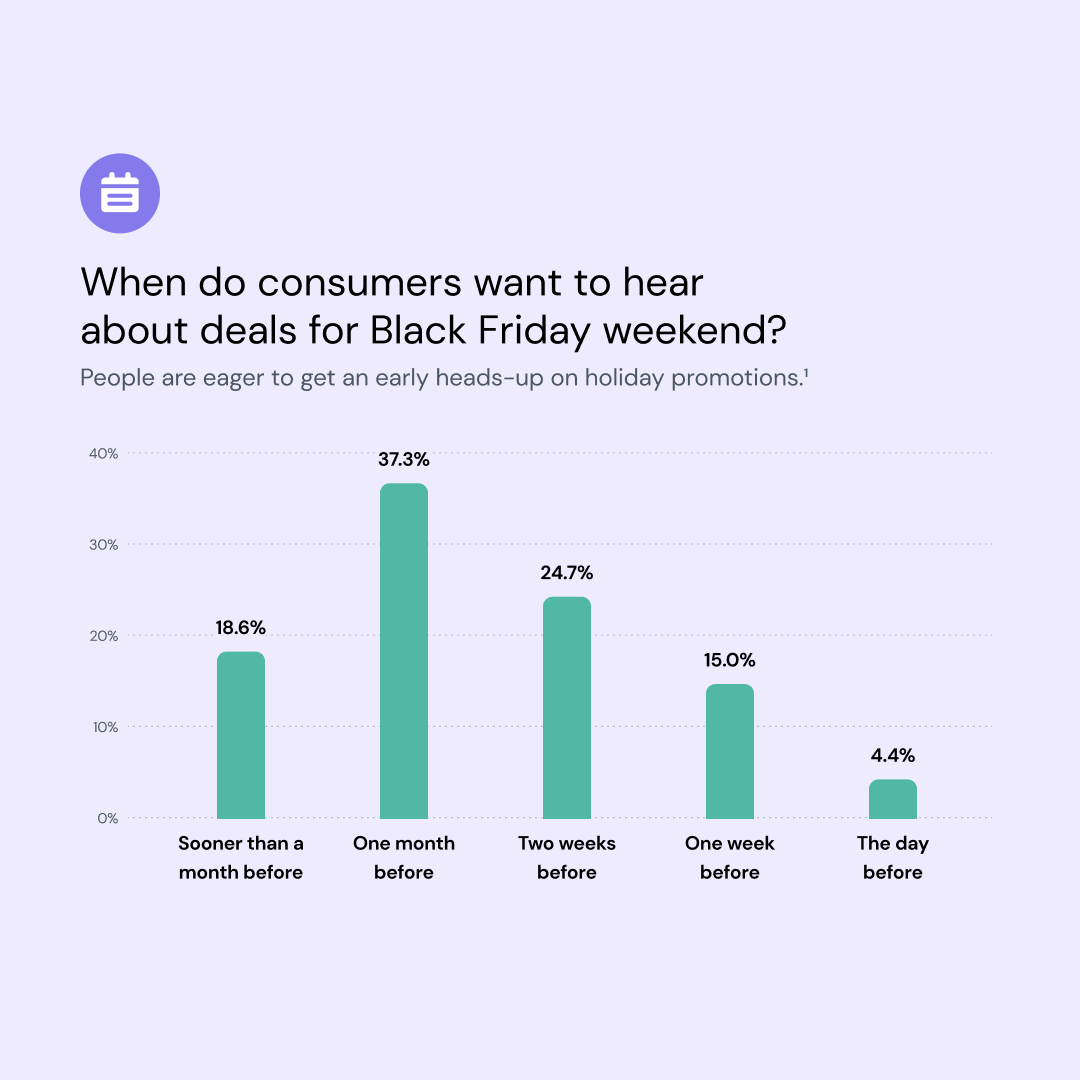
And it’s not just about timing. We also saw that email remains the preferred channel for Black Friday and Cyber Monday promotions, with 56.5% of respondents selecting it over the likes of WhatsApp, websites, and social media ads. Planning early ensures your campaigns reach customers where they actually want to hear from you.
You can see some of the data below:
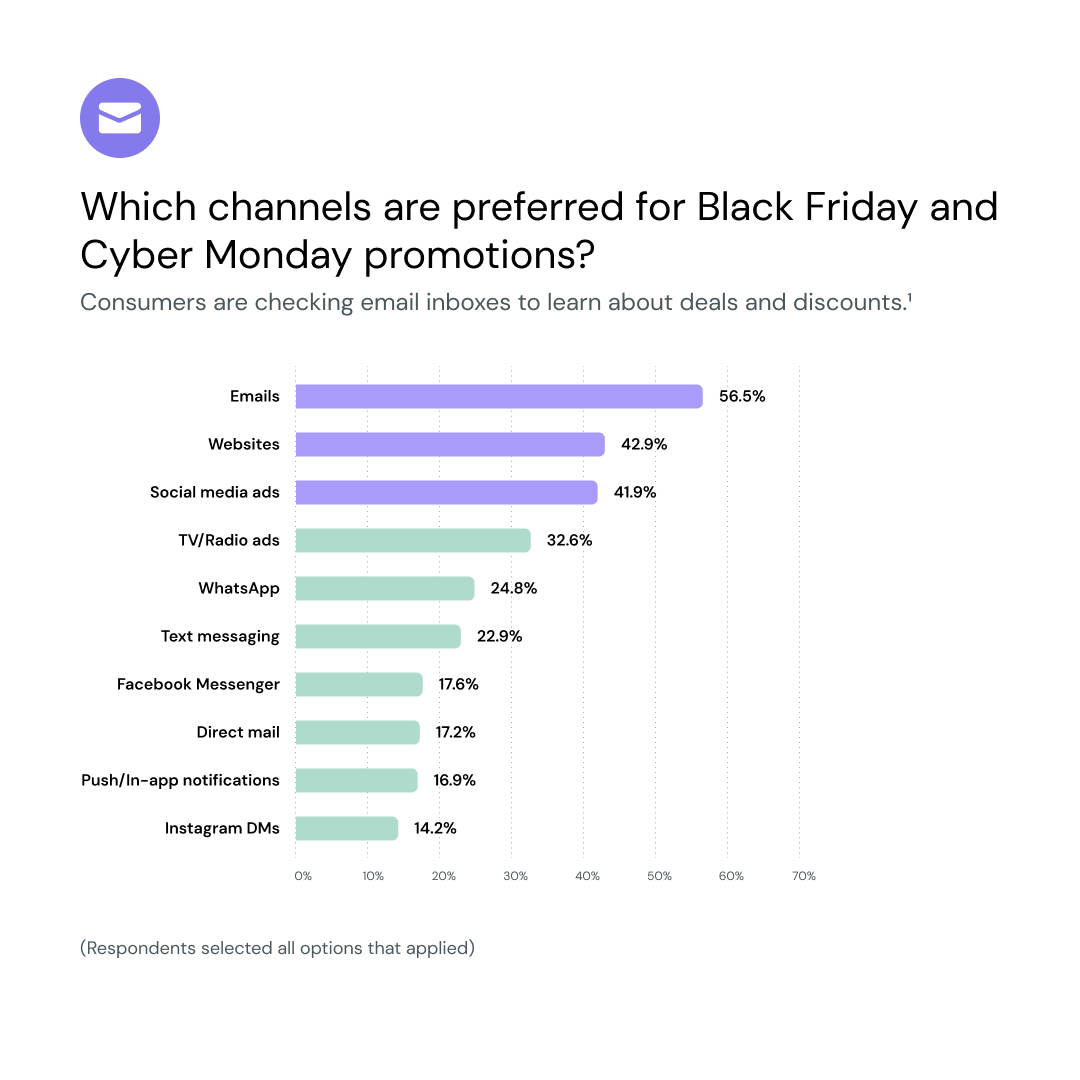
Define your goals and KPIs
Before you start any kind of campaign planning, you need to define your goals. What are they? What does success look like for you? Here are some tips that Julia highlighted in the webinar:
- Tie each campaign to a clear goal so you know what to measure.
- Be specific: Do you want a 20% revenue lift, 15% higher repeat purchases, or more website traffic?
- Don’t just say “increase engagement” – define whether that means. Higher click-throughs, conversions, loyalty sign-ups?
Identify your stakeholders and resources
OK, so you’ve got an idea of what you want to achieve – now it’s time to think about everything needed to make that happen. Firstly, you’re going to want to lock in your audience and segments. Who does this campaign benefit, and within that group, do you need to segment down further? Then you can start getting more tactical.
Julia highlighted some further areas you might want to consider
- Map out who needs to be involved internally within the organization: design, copy, developers, compliance, sales… (if you’re a one-man band well, that’s you!)
- Gather campaign assets early: graphics, product images, promo codes, and landing pages.
- Coordinate across channels – align your social ads, SMS, and website banners with your email campaigns for a consistent brand experience.
- Map out the timing of your sends.
Strengthen your deliverability foundations
Emails that fail to reach your customers and prospects are missed opportunities to connect and engage. That’s why deliverability is often referred to as that “invisible layer” of campaign success. If you skip this, even the best campaigns will fall on deaf ears. So, to combat that, Natalie suggests that you:
- Authenticate your sending domain (SPF, DKIM, DMARC) to prove legitimacy to mailbox providers.
- Regularly clean your lists and validate contacts – in our Road to the Inbox 2025 research, 39% of senders admitted they rarely or never do list hygiene, even though it’s essential for inbox placement.
- Implement a one-click unsubscribe – not just for compliance, but to prevent recipients from marking emails as spam.
Step #2: Send smart and build momentum
With inboxes more crowded than Anfield on derby day, you can’t afford to make mistakes. This means how you roll out your sends – who you target, how you test, and how quickly you scale – can make or break the performance of your campaigns.
So, how do you ensure success?
Warm up before you go big
Warming up your list before BFCM helps inbox providers see consistent, positive engagement, so your emails actually land in the inbox instead of spam. If you blast your entire list at once, you risk high bounces, complaints, and a damaged sender reputation right when you need deliverability most.
- Begin with your most engaged contacts (e.g., those active in the last 30–90 days).
- Gradually expand to larger segments to build positive signals with ISPs.
- Avoid sending to your full list cold – it increases the risk of being filtered to spam.
- Keep an eye on performance metrics and refine your segments throughout the warm-up phase.
“I would suggest that all of September could be considered the “warm-up phase” and perhaps the first two weeks of October, too. So, you’ve got a good two weeks to really build this up.”
Segment and personalize
Generic emails blend into inbox clutter. Segmenting and personalizing your campaign ensures subscribers get offers that feel relevant, which boosts opens, clicks, and conversions. Sending one-size-fits-all blasts, on the other hand, leads to lower engagement and a higher chance of being ignored or marked as spam. Some options you have are to:
- Segment by behavior: loyal customers, first-time buyers, inactive subscribers.
- Segment by engagement: openers/clickers in the last 90 days vs. dormant contacts.
- Use personalization: names, product recommendations, location-based offers.
This isn’t just theory – our research shows that email campaigns that feel anticipated, personal, and relevant perform best. Consumers are more likely to engage when emails look like they were created for them, not for “just another name on a list.”
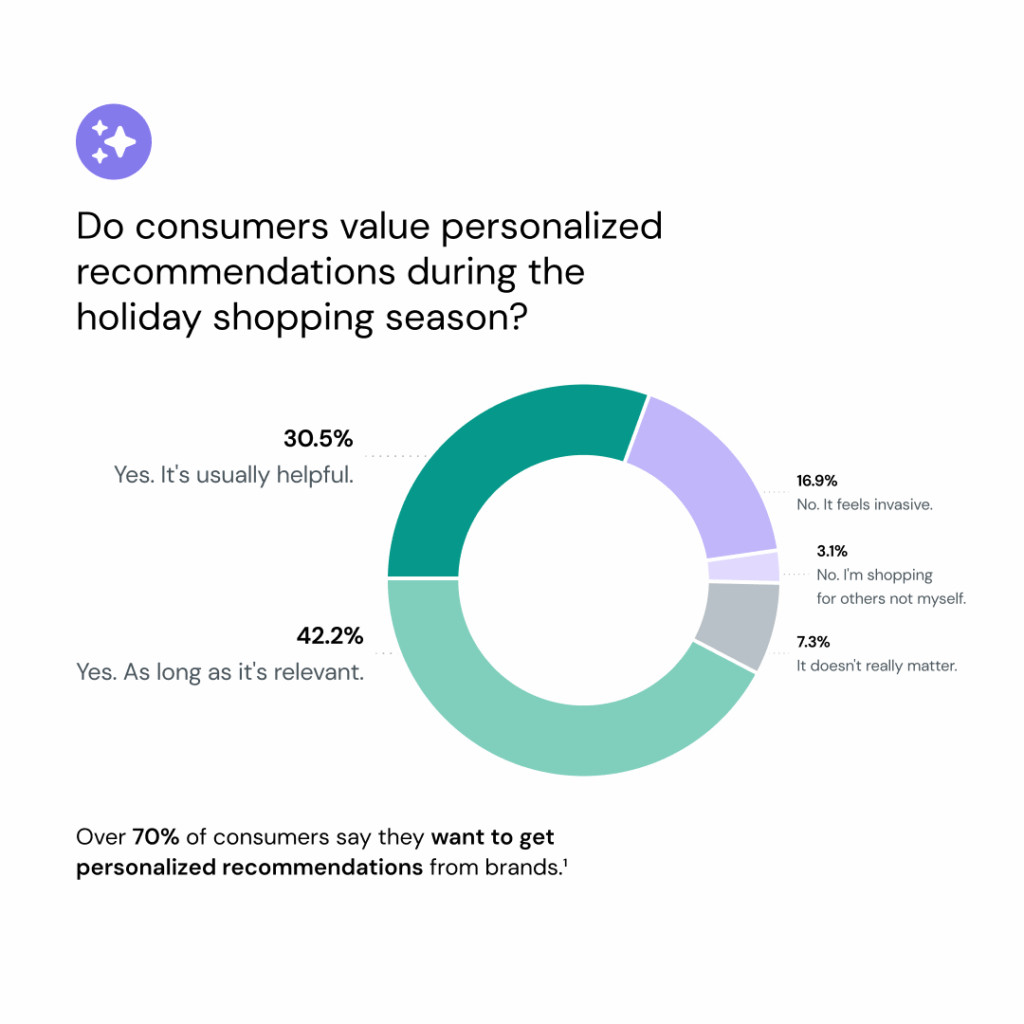
Test before launch
Now, before hitting that send button, it’s important to test and see how your BFCM emails render. This ensures you catch any links, images, and layout issues across devices and inboxes, protecting you from embarrassing mistakes. It also saves revenue and credibility that could be lost if customers see broken or unprofessional emails.
- Preview your emails across devices and clients. A design that works in Gmail may break in Outlook.
- Ensure your A/B tests are set up correctly.
- Run through every link, coupon code, and personalization token to avoid embarrassing errors.

NOW you are able to hit send…
But remember, timing is everything. You don’t want to send your campaign at 9:00 AM Eastern if you’ve segmented your audience by region and this group live in California. Also, make sure you’re using email automation to help schedule your campaigns. Unless you’re the type of sender that needs their finger on the trigger, this can help save a bunch of time and manual effort.
Step 3: Measure and optimize for long-term success
Don’t set and forget! Hitting send does not mark the finish line – it’s the start of a feedback loop. Success around BFCM isn’t about a single campaign but about learning and improving continuously.
Track the right metrics
Beyond checking that the campaign was sent correctly, what metrics should you be tracking, and why? Here are some of the most common to keep top of mind:
- Engagement: opens, clicks, unsubscribes. Which content resonated most with your audience?
- Delivery: bounce rates and spam complaints.
- Conversions: revenue, coupon redemptions, and goal completions from email.
Remember, you’re not just track for the sake of numbers – insights matter. Inboxes are crowded, with consumers receiving dozens of promotional emails a day. Measuring what cuts through will help you refine your future sends.
Wait at least 48 hours after the campaign has been sent to start gathering performance data. This gives enough time to all subscribers to access and engage with your campaign.
Keep the party going
So, what’s next? While you might be ready to hang your hat up and pat your back on a job well done – the real goal here is long-term retention. How can we keep these new subscribers and buyers engaged beyond the holiday season campaign? Natalie ran through a few options for you to consider:
- Send thank-you emails or follow-ups with related product recommendations.
- Provide educational or loyalty-focused content as part of an onboarding or nurture workflow.
- Build post-holiday nurture flows so seasonal buyers become year-round customers.
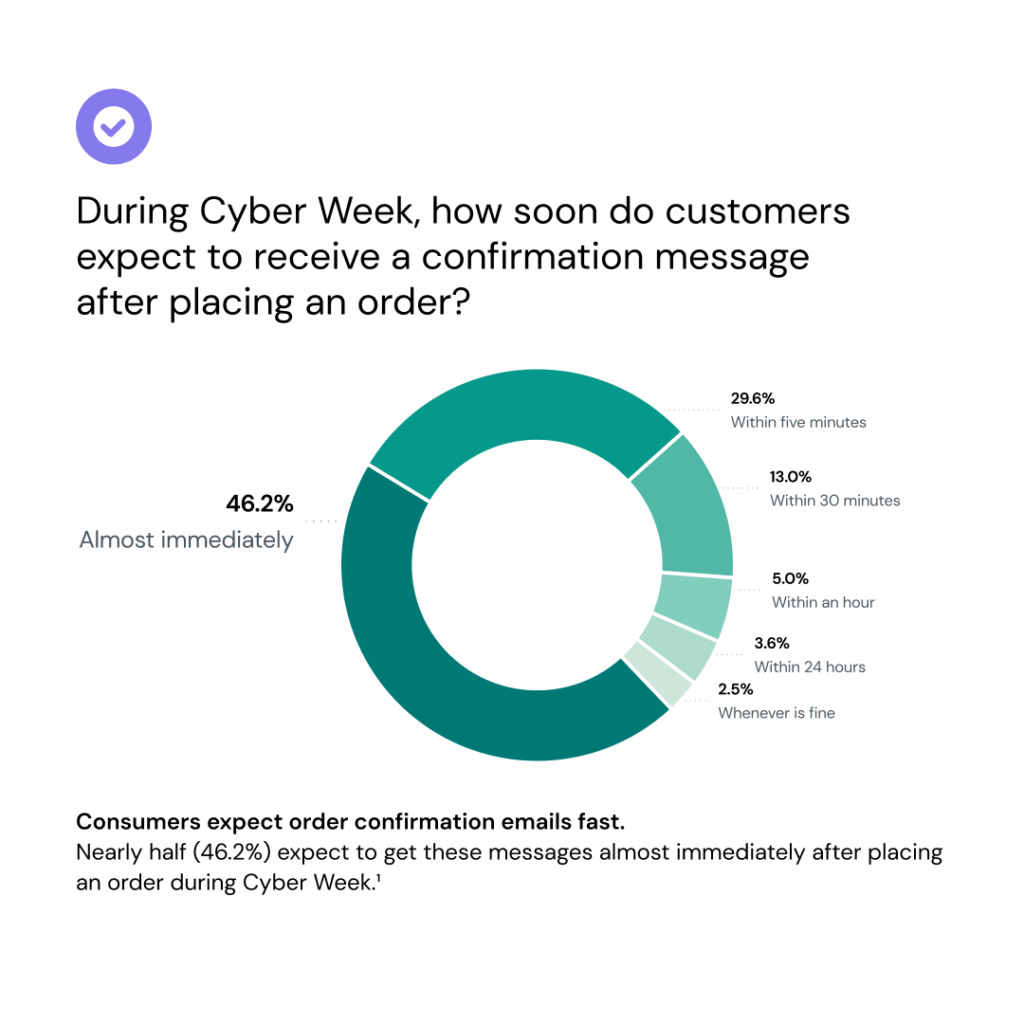
Watch the full webinar
The holiday season is crowded, but the senders who succeed are the ones who prepare early, send smart, and measure carefully. By strengthening your deliverability, segmenting audiences, and continuously refining your approach, you’ll be set up not only for BFCM but for long-term engagement.
Did you miss the live session? Then catch the full recap below:
The post Email Academy: Plan, send, and succeed this BFCM and holiday season appeared first on Mailjet: Email Delivery Service for Marketing & Developer Teams.
]]>The post What is the Gmail automated unsubscribe feature? appeared first on Mailjet: Email Delivery Service for Marketing & Developer Teams.
]]>One of those email actors leading the way when it comes to change is Gmail, which is constantly incorporating features and automations to take the inbox experience to a new level. Of course, with an estimated 1.8 billion Gmail users in 2023, understanding the inbox’s features is a must for email marketers.
In this post, we’ll talk about the Gmail automated unsubscribe feature, what it means to senders, and why this is going to be so important to you come February 2024.
Table of contents
What is the automated unsubscribe feature on Gmail?
A while back, we talked to you about how Gmail was already adding some then-new sophistication to this header option that allows users to easily cancel their subscription to marketing emailing lists.
While the ability to unsubscribe from a contact list on Gmail has been available for some time, it had always been up to the users to determine which ones they wanted to be removed from.
Currently, Google has fully leaned into that sophistication by automating that process and actively asking the users whether they’d like to unsubscribe from certain promotional emails they haven’t opened in the last 30 days or more.
The unsubscribe suggestions are based on how many emails users receive and open from a specific sender and it means that, with just one click on the Unsubscribe button, the newsletter subscriptions will be terminated, making it even easier for recipients to stop receiving all of those unwanted emails.

How can recipients unsubscribe from your emails on Gmail?
As a marketer, it’s worth understanding the different unsubscribe options available to recipients using Gmail.
Let ’s go through some of them quickly.
Unsubscribe link in emails
The first way recipients can unsubscribe from emails is by clicking on the unsubscribe link that needs to be included in all email marketing campaigns.
Of course, as you’ll be following email marketing best practices as a sender, you’ll include an easy-to-find unsubscribe link at the bottom of your newsletter template, making it simpler for unengaged recipients to say goodbye.
This is good practice for protecting your deliverability and it also ensures you’re completely compliant with anti-spam legislation (GDPR, CAN-SPAM, CASL, etc.). And in 2024, it will be a non-negotiable for bulk email senders targeting Gmail and Yahoo users.
Here’s an example from our newsletter below:

Gmail’s unsubscribe button on the email header
If you’re a Gmail user yourself, you’ve probably noticed that some emails have an Unsubscribe button at the top of the email, next to the sender’s email address.
You can clearly see it highlighted in the example below.

Sometimes, this unsubscribe link is also accessible by clicking the sender card to get more details.
If you’re a frequent Mailjet reader, you’ll know that adding an unsubscribe link is the best way to protect your sender reputation and avoid users from sending your email to spam.
That’s why many senders choose to incorporate a list-unsubscribe header to their emails, which makes it easier for webmail clients like Gmail to find unsubscribe settings and display them at the top of the email. If you’re sending emails from Mailjet, the list-unsubscribe header is added to your campaigns by default as a way to protect your deliverability.
On mobile apps, this unsubscribe button can be found by entering the email and clicking on the options icon in the top right-hand corner of their screen – shown as a three consecutive dotted symbol.
This will force a drop-down menu (such as the example below) with the option available to unsubscribe.
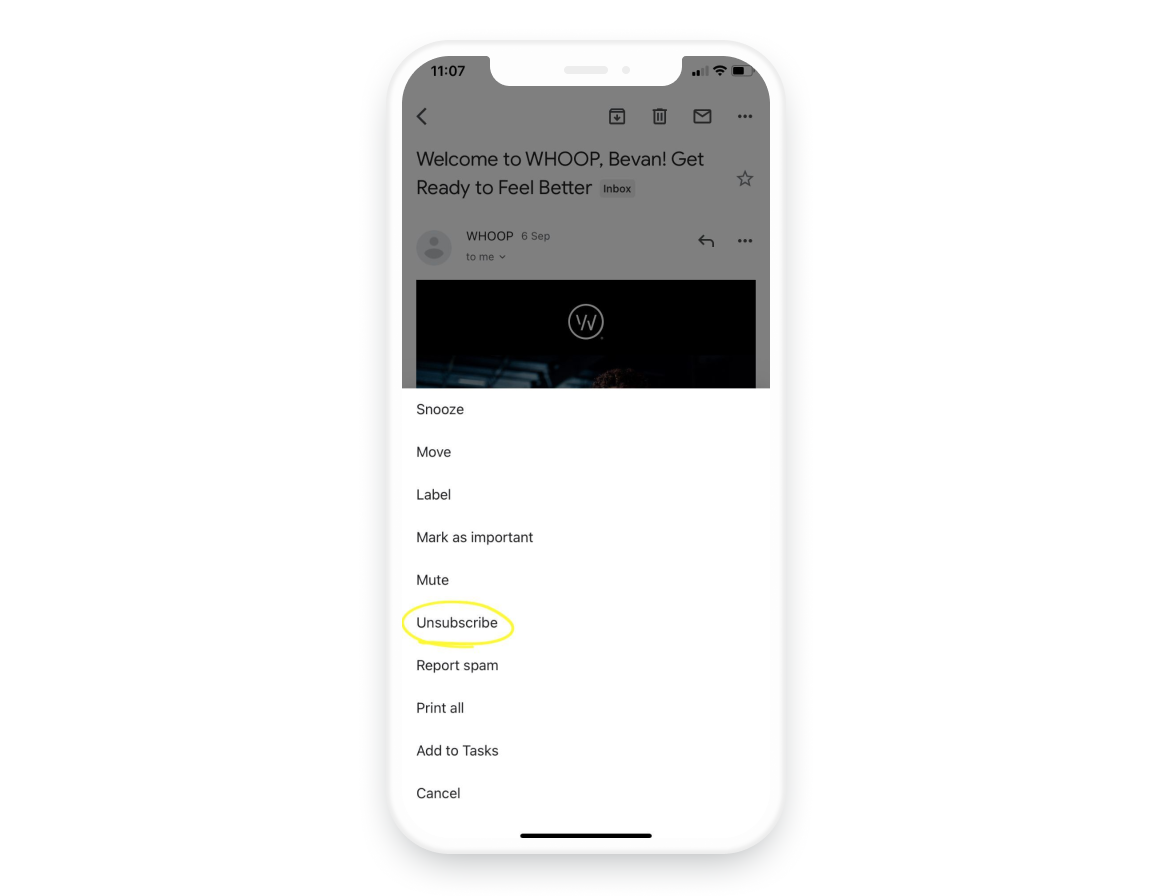
Gmail’s block option
A block isn’t the same as an unsubscribe, but sometimes recipients will default to this if they can’t find an easy way to cancel their email subscription.
Gmail’s block option is easy to find both on desktop and mobile by accessing the message options via the three dots on the right-hand side.
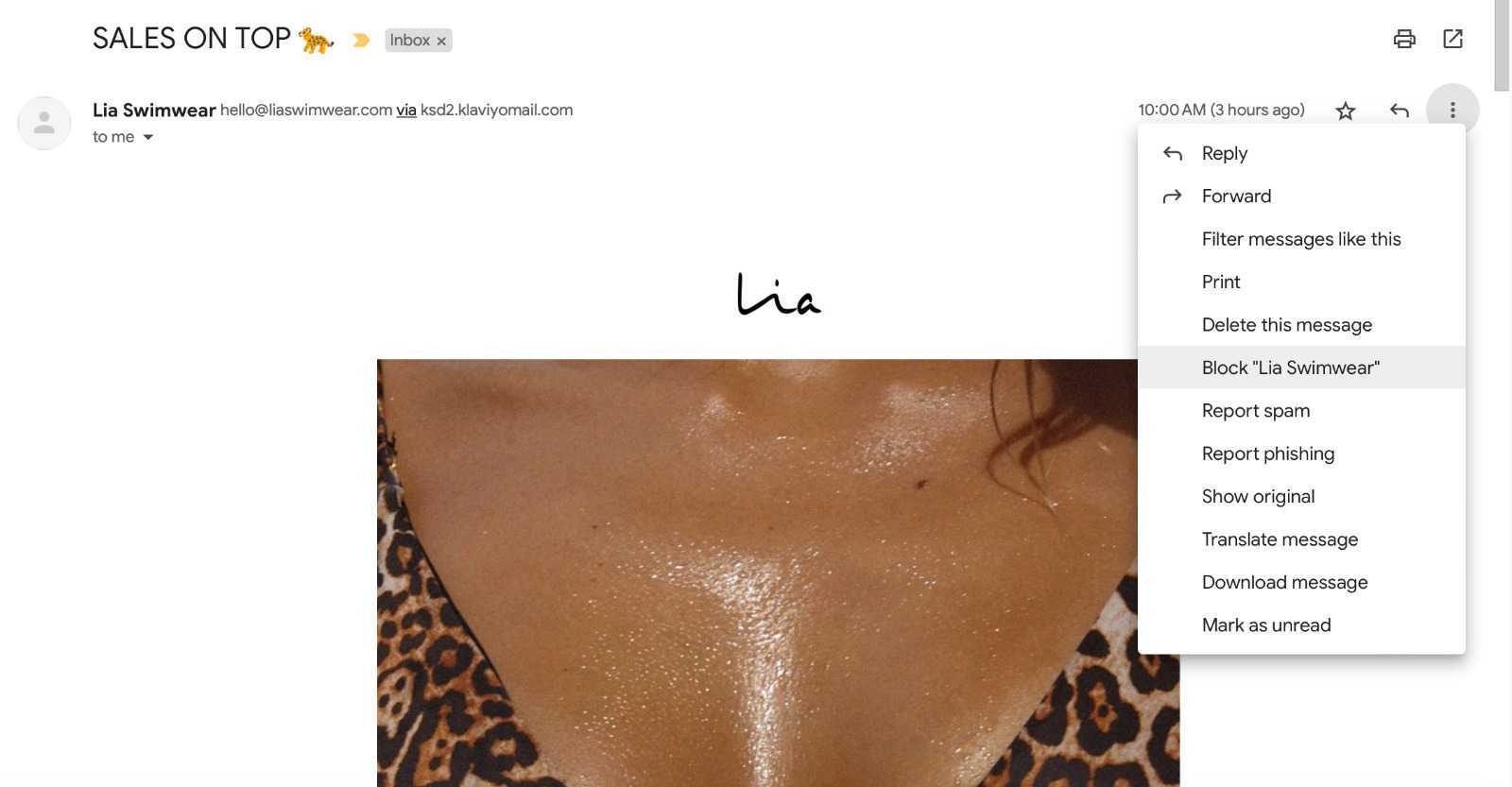
Marketers should beware of this block option, though. When a recipient chooses to block an email address or sender, Gmail will directly reroute this mail to the spam folder. As a sender, you’ll never know you’ve been given the silent treatment – you’ll just see the impact in your email deliverability.
An unsubscribe, on the other hand, lets us know that they no longer want to receive a certain type of content (newsletter, new blog postings, etc.,) with the onus then being to remove recipients from said list. That’s why at Sinch Mailjet we always recommend giving recipients an easy way out.
Automated unsubscribe recommendations
The final option for recipients is Gmail’s automated unsubscribe feature, of course.
Just as we previously explained in this post, this automated feature flags brands the user hasn’t interacted with in a period of time and offers recipients a fast way to unsubscribe from them.

While the previous options rely on a user actively choosing to opt out of your email program, Gmail’s automated unsubscribe recommendations create a new dilemma for marketers: What can you do if Gmail is telling your contacts to unsubscribe? And what will this mean for your email program?
What does the Gmail automated unsubscribe feature mean for email marketers?
Quite frankly, it means that your recipients have an easier way to cancel their email subscription. So, if your newsletters are boring or irrelevant, and the reader has not opened them in a while, they’ll be prompted to unsubscribe.
Don’t panic, though. The Gmail automated unsubscribe link doesn’t have to be seen as an enemy. They could already do this with tools like unroll.me, couldn’t they? In fact, it can be seen as a way to help you clean your contact lists, which in turn improves your deliverability rate.
On top of that, if you apply email list cleaning best practices, like regularly sunsetting inactive contacts and running requalification campaigns to re-obtain consent from your newsletter subscribers, you have an up-to-date database of contacts that are interested in receiving your communications and your content. And we’re pretty sure you did, didn’t you?
All in all, what’s important to remember is that this is yet another way to keep your email list clean. At Sinch Mailjet, we always recommend that you remove inactive contacts every three to six months to ensure your open and click-through rates remain at a healthy level, to ensure the best deliverability.
The bottom line is, if you continue to strategically plan and implement your newsletter campaigns, you don’t have to worry about the unsubscribe feature.
Send me the Mailjet newsletter.
What are the February 2024 Gmail unsubscribe link requirements?
You may have heard that Google and Yahoo plan to make some serious changes when it comes to securing subscribers’ inboxes.
Well, you heard right – as of February 2024 Google announced it’ll be requiring senders to abide by a set of industry best practices to both improve email authentication and deliverability.
These new requirements will affect bulk senders – those sending over 5000+ to Gmail addresses in one day – with one of them being the mandatory inclusion of a one-click unsubscribe option for readers.
Now, seeing as most email senders will be attempting to reach Gmail and Yahoo inboxes, this likely affects you. So, what can you do to ensure you comply with these new mandates?
|
What you’ll need |
How to get there |
|---|---|
|
Same for Gmail and Yahoo: A single-click pathway for users to easily unsubscribe from your messages from within the mailbox provider’s UI using list-unsubscribe headers, and internal support to honor unsubscribe requests and remove addresses from relevant email lists within 2 days. |
Senders will need to put list-unsubscribe post headers into the header of their email as specified by RFC 8058. |
How to avoid Gmail mass unsubscribes
At Sinch Mailjet, we think the strongest email campaign is the one your contacts really want to receive. The best solution to avoid contacts unsubscribing is to create targeted and relevant emails, and to only send them to those that actually interact with your communications.
To help you maintain an engaged subscription base, here are some top tips.
Segment your contact lists
Don’t send the same email to all your contacts. Use segmentation to send content that is tailored to your contacts based on different data, such as behavior, location, age, and gender. Combine it with personalization to make it even more human. The more relevant your email is, the more engagement it will generate among your subscribers.
Send reactivation and retention campaigns to inactive contacts
Every three or six months, identify subscribers that haven’t interacted with your emails and send them a special campaign in which you remind them of the value they offer, and in which you ask them to confirm their subscription or take an action using their account. You can include a survey to understand what content they’d like to receive, or highlight what they have missed in those past months. Because of these reminders and attention, they’re less likely to take the unsubscribe option and more likely to stay with you.
A great example of a reactivation campaign comes from the home decor company Framebridge. In this email, they ask the recipient to confirm that they want to stay on Framebridge’s mailing list.
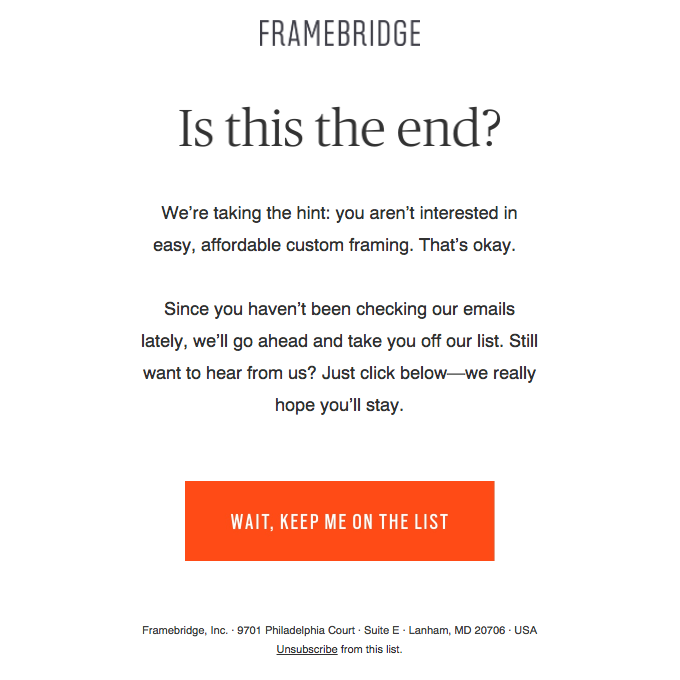
The email is short, to the point, and gets its message across. Additionally, the email uses color to draw attention to its call-to-action, which takes the form of a large, colorful button. It’s very easy for any reader to understand how to take action and keep themselves on the mailing list. This email deserves a frame, right?
Okay, we tried.
Set up sunset policies for inactive users
No, this doesn’t mean inactive users are jetted off on holiday to the Andalusian coast, cocktail in hand, to enjoy one of Europe’s finest sunsets…
A sunset policy is a common email segmentation strategy that identifies and discontinues sending emails to disengaged contacts or subscribers who don’t open your emails.
However, there’s big difference between cleaning your list and sunsetting. While you often only conduct list cleaning every few months, an automated sunset policy allows you to automatically identify disengage contacts and promptly exclude them from your email sends, effectively mitigating the negative impact they could have on your email deliverability.
Use our Exclusion List to avoid sending emails to inactive contacts
If you don’t want to remove your zombie contacts from your list forever, you can add them to your Exclusion List. This way, contacts will stay in your database, but won’t receive your emails.
You can find your Exclusion List inside the Mailjet app. To do so, you’ll just need to click the Exclusion List button under the Conctacts drop-down in the top menu.
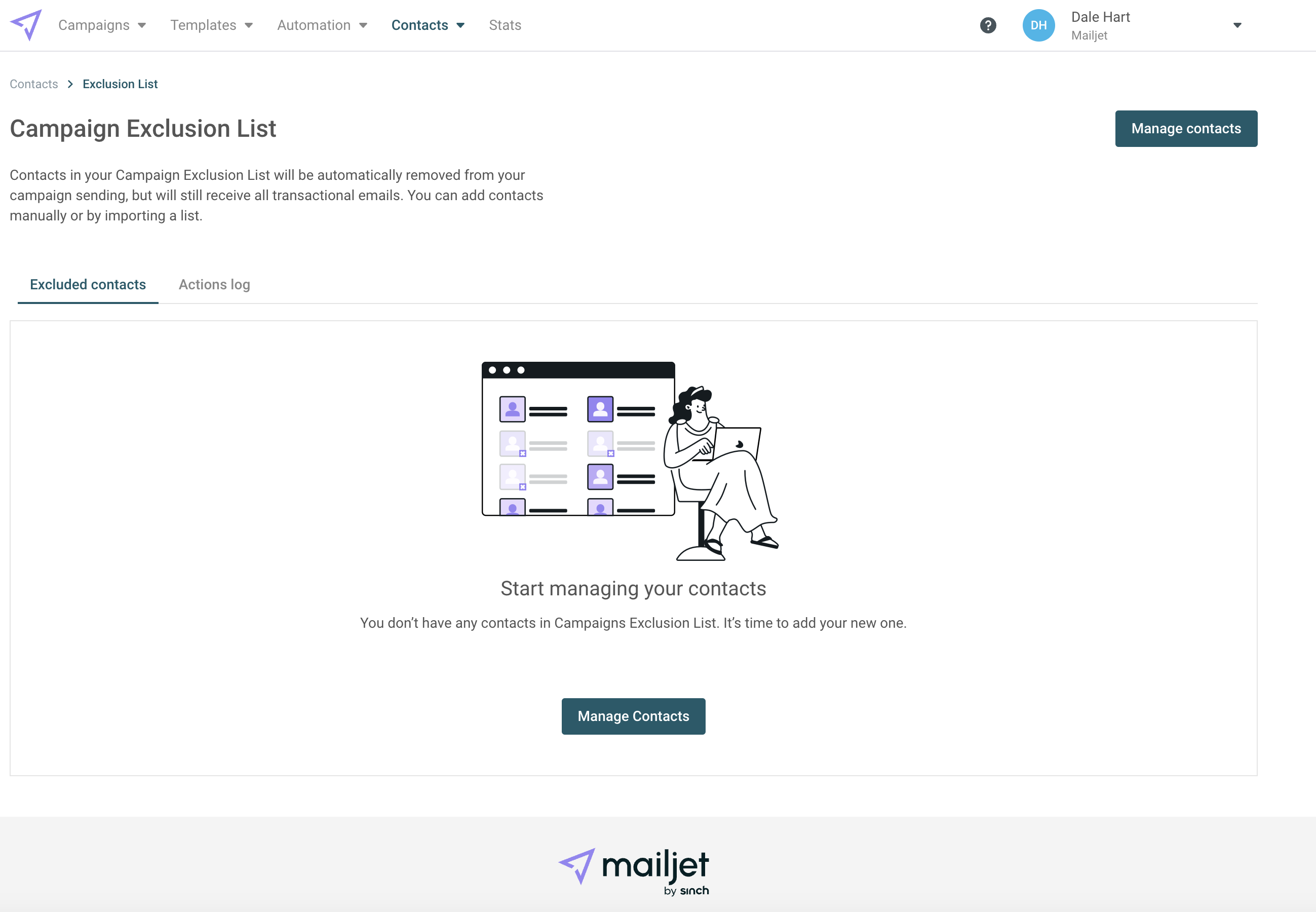
Wrapping up
The Gmail automated unsubscribe feature might feel spooky at first but, by following the above tips and continuing to use email best practices, you can ensure that you’re keeping your email program as healthy as possible. That way, as Gmail and other services continue to refine their features, your mailing list and customer relationships will stay strong.
Send me the Mailjet newsletter.
The post What is the Gmail automated unsubscribe feature? appeared first on Mailjet: Email Delivery Service for Marketing & Developer Teams.
]]>The post Noreply email address: Best practices for your email strategy appeared first on Mailjet: Email Delivery Service for Marketing & Developer Teams.
]]>Noreply addresses are the brick wall of digital marketing – no matter how much recipients try to get their message through, there’s just no way to contact the sender.
But what role does this type of address play in an email strategy? In this post, our friend Chris Arrendale, CEO and founder of Inbox Rev, explains what a noreply address is and why sending your marketing emails using a reply-to address is always the best idea.
Table of contents
What is a noreply email address?
A noreply email is an email address that is not monitored and blocks customers from replying. You’ve likely seen this type of sender address before – most of the time it looks like this: noreply@domain.com.
There is a misconception that sending from a noreply email address is the best way to go to avoid being flooded with email replies. Many businesses use this type of email address for receipts or account creation and shipping confirmations. However, it can confuse and frustrate customers if their replies go unanswered or worse – bounce.
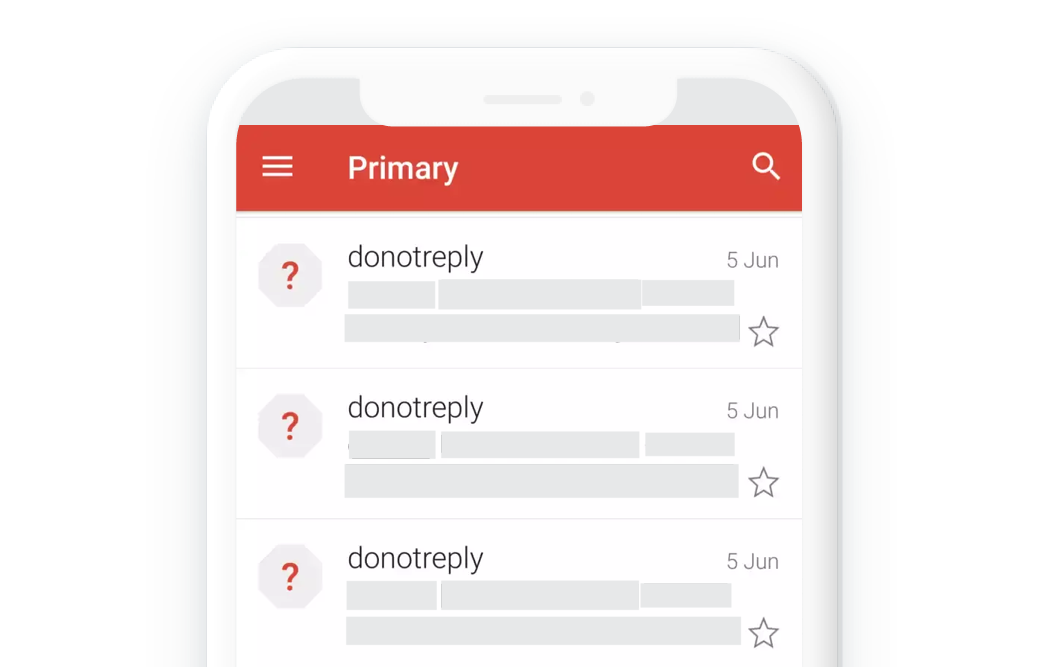
Noreply email examples
Still unsure of what a noreply email looks like in your inbox? We’ll highlight a few of the most common examples you’ll likely receive from brands:
Product/Service subscription
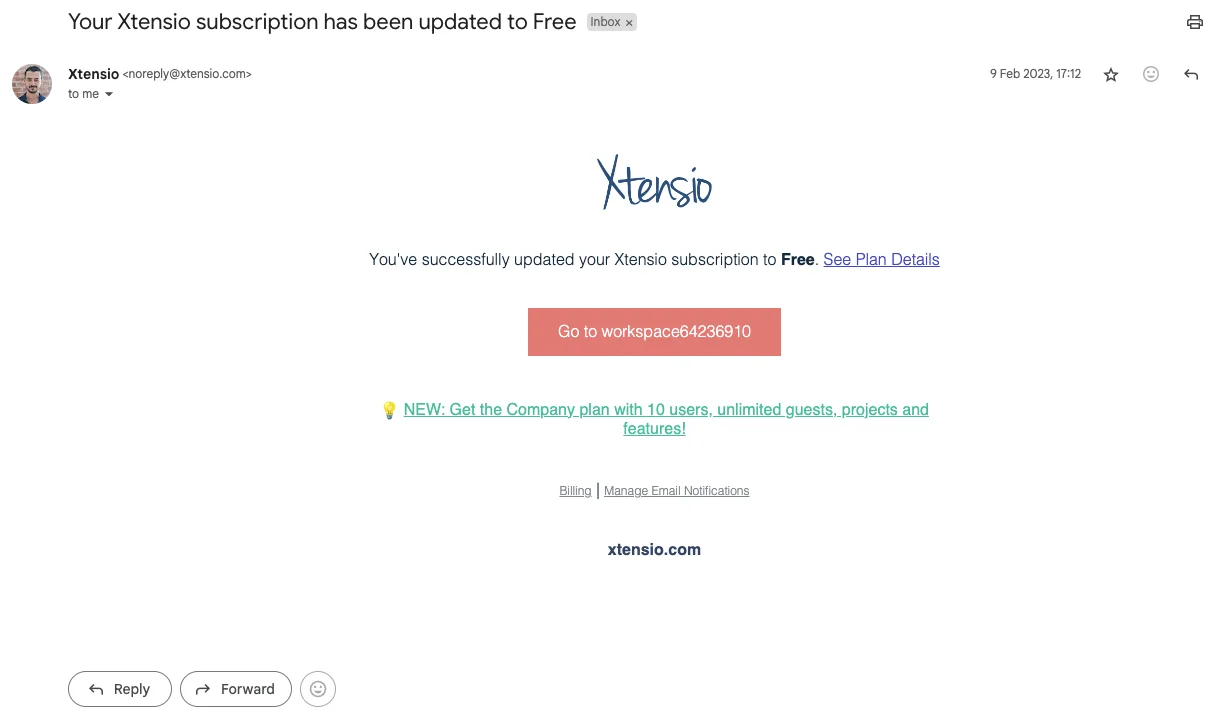
Terms of service changes
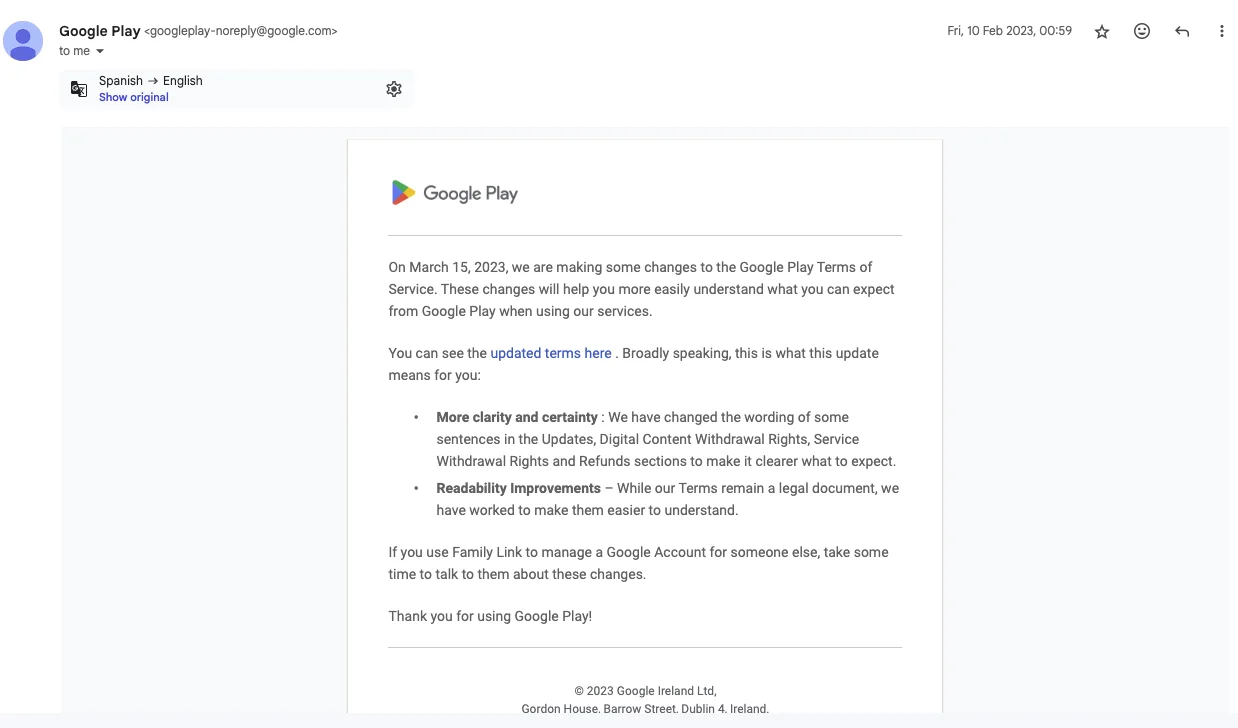
Email/Account verification
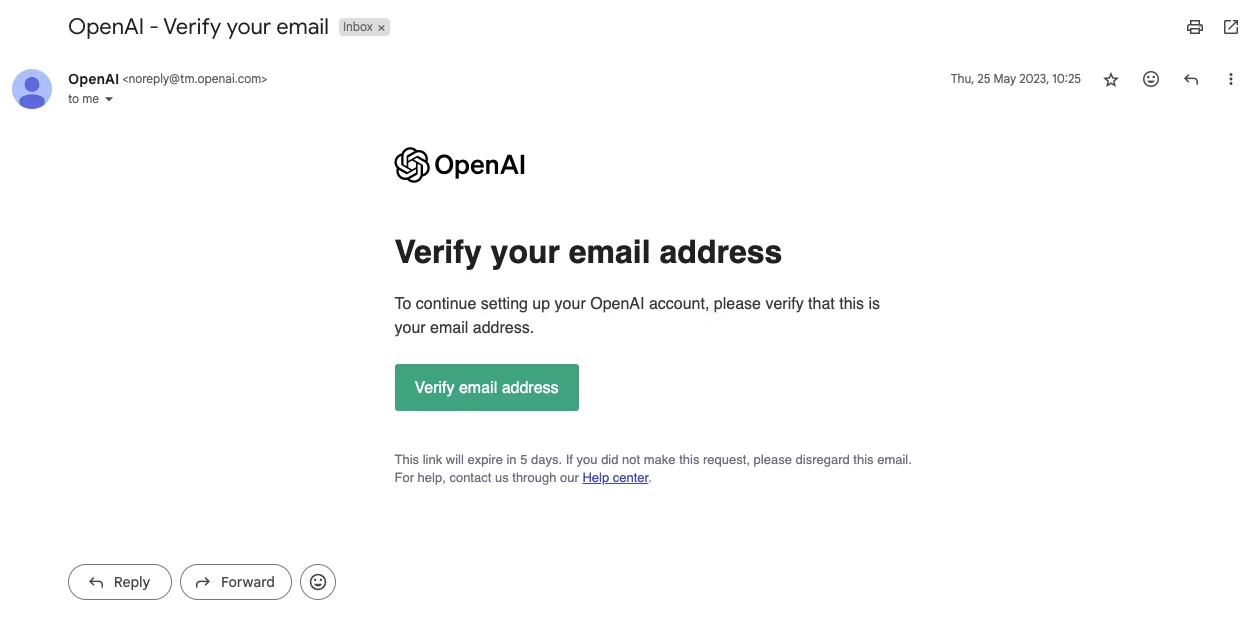
Welcome email

Order/Purchase confirmation
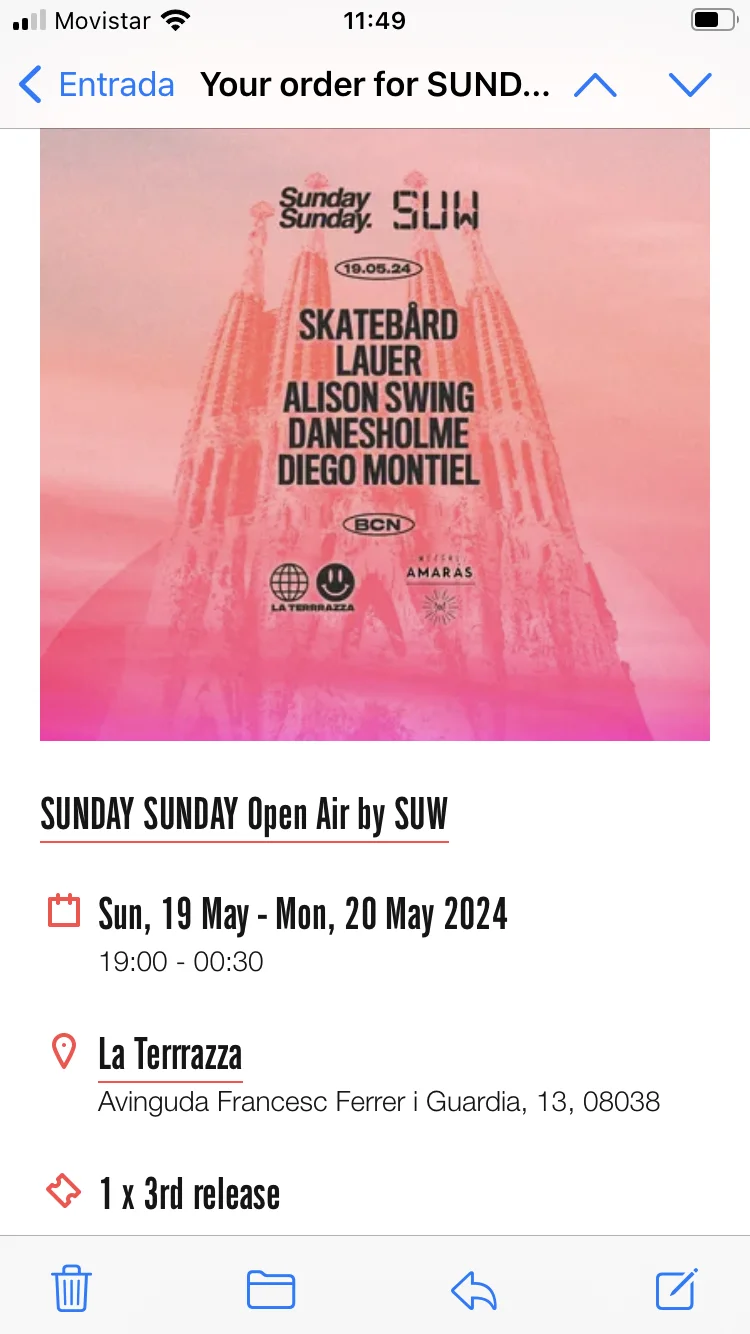
Let’s explore why it’s never a good idea to use a noreply email address for your email marketing campaigns and what you should use instead.
Why you shouldn’t use a noreply address in email marketing
While noreply addresses are tempting, there are a few reasons why you shouldn’t use one. Here are the most important things to consider:
It decreases deliverability and increases spam foldering
Certain ISPs, network spam filters, and customers’ personal email security settings are set up to send noreply email to the junk folder. This will decrease your open and overall deliverability rates and will increase your chances of landing in the spam folder. Being inboxed less leads to lower possible conversions, especially when sending blast emails.
Also looking at email trends from a broader sense, 53% of email is opened on mobile devices. To accommodate for the smaller screen, many email clients set their inboxes on mobile devices to just show a preview of the sender and your email address as well. As a consumer, would you open an email with a noreply email address? You’re more likely to feel like a company is unapproachable.
Send me the Mailjet newsletter.
It can hurt your customer experience
When a customer replies to an email, it’s because they have something to share. They could have a support question, a comment about your product or service, or just some constructive feedback that can help a brand with its marketing efforts. Adding your contact information to your email campaigns will help direct some of these comments, but it’s likely many of your customers still opt for just replying to your campaigns. If they get an auto-reply notification telling them the email can’t be delivered, how do you think they’ll feel?
Post-GDPR, it is also more important than ever to take the time to evaluate whether you should use a no-reply address for your marketing campaigns. How can you expect your subscribers to contact you to claim their rights if you don’t allow them to do so? An autoresponder is just not good enough.
Swapping out the noreply for a reply-to address
Most ISPs do not allow email recipients to add noreply emails to their address books. If a recipient can’t add you to their address book, you’re more likely to be flagged as spam and sent to the junk folder. It is also much more likely for subscribers to hit the spam button if they can’t reply back requesting removal of their email address. I’ve seen cases where customers unsubscribed from some of their favorite brands because noreply emails addresses were not being monitored.
Another interesting point to remember is that it shows credibility to ISPs when recipients engage with your email, replying to your email being one of those cases. Safe sender privileges include bypassing some of an ISPs mail filters and delivering straight to the inbox.
Best practices when sending email replies
Hopefully, by now you understand the importance of adding a reply-to address to your marketing and transactional emails. To help you implement yours, here are some best practices you should keep in mind.
Create a dedicated email address for email responses
Setting up a dedicated reply-to address will help you filter and follow up on customer feedback. Create an email distro and ensure relevant team members, like support team agents or community managers, have access to the address.
For example, you could set something up like:
- hello@company
- contact@company
- helpdesk@company
- information@company
- support@company
Sometimes, that dedicated email address might be connected to support software tools like Zendesk, which allow companies to create a generic support email address for incoming support tickets.
If you’ve not set up a custom domain yet, we highly recommend you do so. It improves your sender reputation, builds brand credibility in the inbox, reduces susceptibility to phishing, and helps with email authentication.
However, if you’ve not got around to setting up a custom domain yet and are using a free email provider such as Gmail, this can still be set up easily.
Set up filters for specific autoresponders
We’ve all suffered it. Every company’s reply-to address usually receives an influx of out-of-office messages and other automated responses after a campaign is sent.
To avoid these types of messages clogging your dedicated email address, filter out messages containing keywords such as “delivery notification” or “out of office” in the subject line or body of the email. This will make handling the legitimate messages easier.
Keep an eye on the unsubscribes
As mentioned before, some people skip over the unsubscribe link and reply directly to your email asking to be removed. These customers bypass the unsubscribe link because they’re afraid it will only flood their mailbox with more emails.
Make sure you honor these requests promptly and remove the email addresses from your list. The last thing you want is for these recipients to feel like they are being unheard and in frustration, mark your email as spam.
Also, monitor your reply email address if you’re sending to a domain where the recipient never opted into your email program (something you shouldn’t be doing anyway). The mail administrator (at the recipient’s domain) may try to contact you at your reply email address.
This is a crucial moment because if you don’t respond back, the email recipient may report you to a blocklist and/or try to contact the email service provider (ESP) or data center to complain about your email.

Build the best conversation
A reply-to email address is essential to any email marketing program. It fosters two-way communication and nurtures the conversation between you and your customers.
Many B2B senders will use a sales person’s email address as the reply-to to keep the conversation personal and on a more one-to-one level, while B2C senders may use a general reply-to address that may be monitored by multiple email marketing professionals.
Both scenarios build the confidence that when the recipient replies to the marketing email, the email will be received and followed up on.
Provide support throughout the customer journey
Often, customers reply to emails because they have a support request or concern, or there’s probably something in your email they want to know more about.
When planning your campaigns, think about the kind of questions users might have and proactively offer resources that help answer them.
This will be especially important post-purchase or during the onboarding period. Including links to additional resources, FAQ pages, technical documentation, or your help center will help reduce the number of responses your reply-to address gets and improve your customer experience overall.
Summing up: Say NO to noreply email addresses
To sum it up, the noreply email address should never be used to send from. It tells your customers that you don’t really care what they have to say.
By using a noreply email address, you’re also missing out on an important opportunity to collect feedback and learn how to improve your product and also it’s not the best way to grow your email list.
So now you know: Swap your noreply to a reply-to email address and build a stronger relationship with your recipients.
Want to learn more about email deliverability best practices? Sign up to our newsletter now and get all the tips and tricks in your inbox.
***
This blog post was written by Chris Arrendale, the CEO and Founder of Inbox Pros. Chris has more than 13 years of experience in the technology and software industry and has worked directly with many different ISPs, webmail providers, spam filter providers, blocklists, and partners to resolve email deliverability and privacy issues. He works with many leading organizations and enterprises to ensure regulatory compliance and maximum deliverability across all systems.
The post Noreply email address: Best practices for your email strategy appeared first on Mailjet: Email Delivery Service for Marketing & Developer Teams.
]]>





